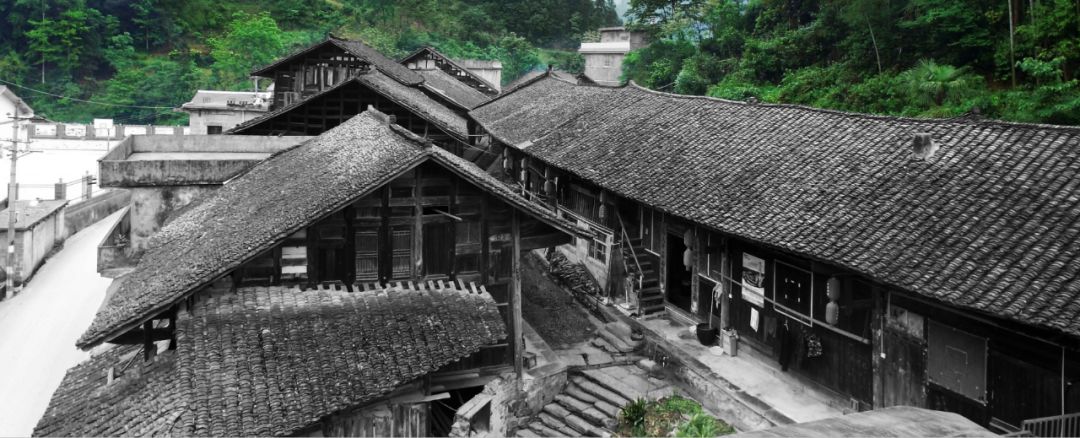 两河口:土家盐道古村的再生
两河口:土家盐道古村的再生
国际四校联合设计研学营
Lianghekou: Regenerationof an AncientTujia Village along Salt Road
JointDesign Teaching Studio
Southeast University
IUAV UniversitàIuav di Venezia
Huazhong University of Science and Technology
Chongqing University
1.课程背景
1.Studio Introduction
两河口村,位于湖北恩施土家族苗族自治州宣恩县,是明清时期“川盐济楚”盐道沿线的商贸村镇。百米古街保存完好,典型反映了鄂西土家族苗族吊脚楼建筑的建构特征和商贸市村的聚落形态。由于人口流失,商贸凋敝,曾经兴盛的古村陷于衰败。
两河口村所在的沙道沟镇目前正在迎来发展的契机。以国保遗产彭家寨为代表的土家族村寨正在吸引世界的目光。2019年高速公路的通达将为这条沉寂的盐道山谷带来大量客流。如何在迅猛的旅游业发展中,避免浅表性的消费,保存和发展国家级文化遗产的价值内核,使得沉睡的古村得到再生,这不仅是本次联合教学的主题,也是包括威尼斯在内的人类文化遗产共同面临的挑战。
Lianghekou Village, located in XuanenCounty, Enshi Tujia and Miao Autonomous Prefecture, Hubei Province, was acommercial village along the ancient salt road during the Ming and Qing dynasties.The one-hundred-meter street, which typically embodies the tectonic characteristicsof Tujia and Miao stilt house and the settlement pattern of commercialvillages, has been well preserved. As a result of population loss andcommercial decline, the once thriving ancient village is suffering from the decay.
At present Lianghekou Village is embracing theopportunity of development. Tujia villages represented by the national heritageof Pengjiazhai is attracting the attention from the out world. The opening ofthe highway in 2019 will bring numerous visitors to this hidden salt roadvalley. How to avoid superficial consumption and preserve the core value of thenational cultural heritage in the rapid development of tourism, so as toregenerate the declined ancient village, is not only the topic of this jointteaching studio, but also the common challenge faced by human culturalheritages worldwide, including the city of Venice.
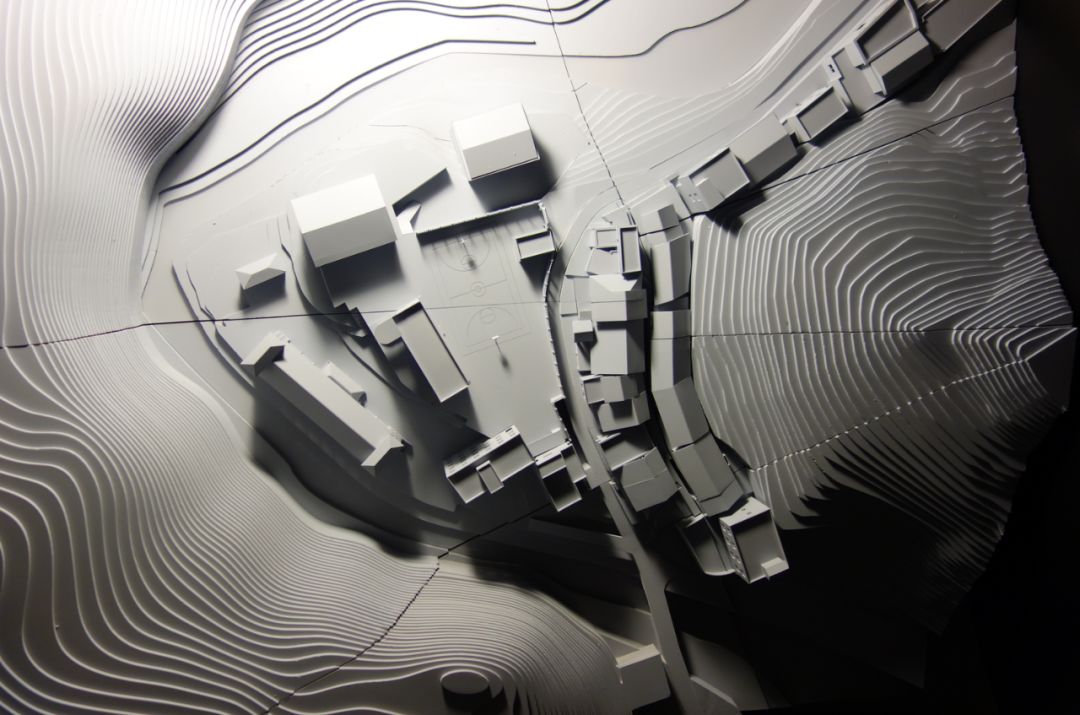
两河口老街场地模型 The model of the site
2.教学目标
2.Objectives
1. 证明与展现面对濒危脆弱的文化遗产,建筑学自身具有的力量和承担的责任;
To demonstrate the power and responsibilityof architecture in face of the increasingly endangered and fragile cultural heritage.
2. 寻求一种建筑学的学科韧性,既
错失旅游经济带来的发展契机,同时保存和延续历史遗产的原真价值与文化认同。
To seek are silient discipline ofarchitecture, which will not miss the opportunities brought by tourismdevelopment, but also preserve and continue the authenticity andcultural identity of historical heritage.
3.课程进程
3.Course Schedule
2019.4.28 湖北恩施土家族自治州彭家寨举行国际四校联合研学营开营仪式。
The lanuching ceremony of the joint studio of four international schools was held in Pengjiavillage, Enshi Tujia Autonomous Prefecture, in Hubei Province.
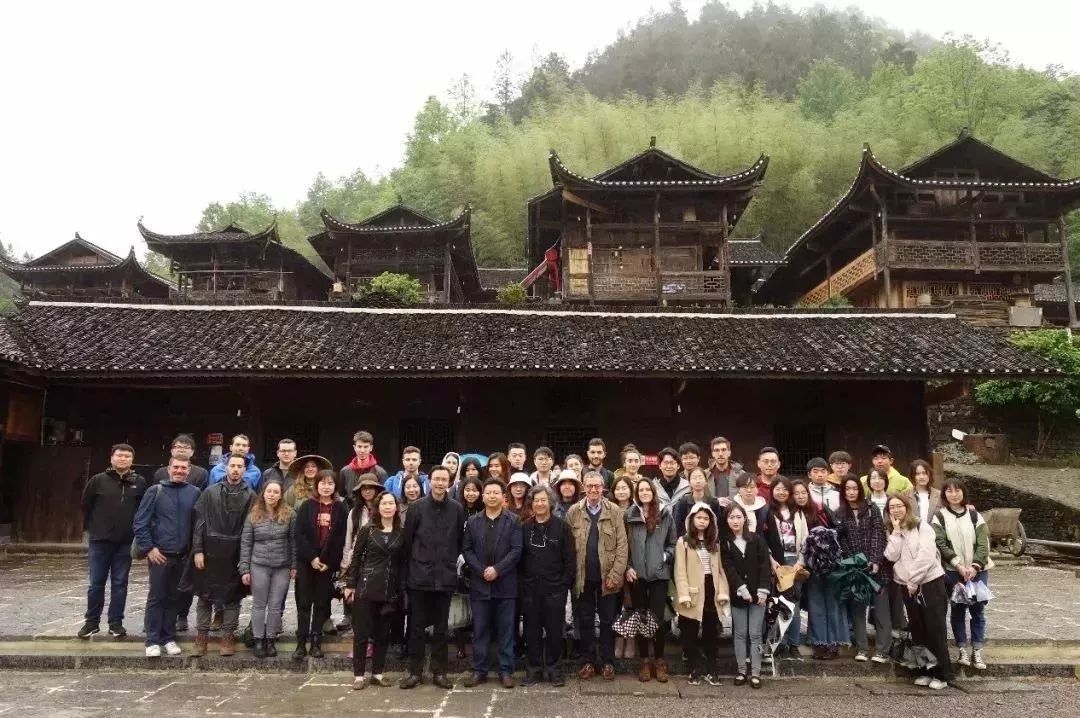
国际四校联合工作营开幕式the lanuching ceremony of international joint studio
2019.4.29---5.4两河口村,为期一周的田野调查,包括详细测绘与场地及周边环境调研。
A week-long field survey, including detailed mapping of site and fundamental investigation in Lianghekou Village.
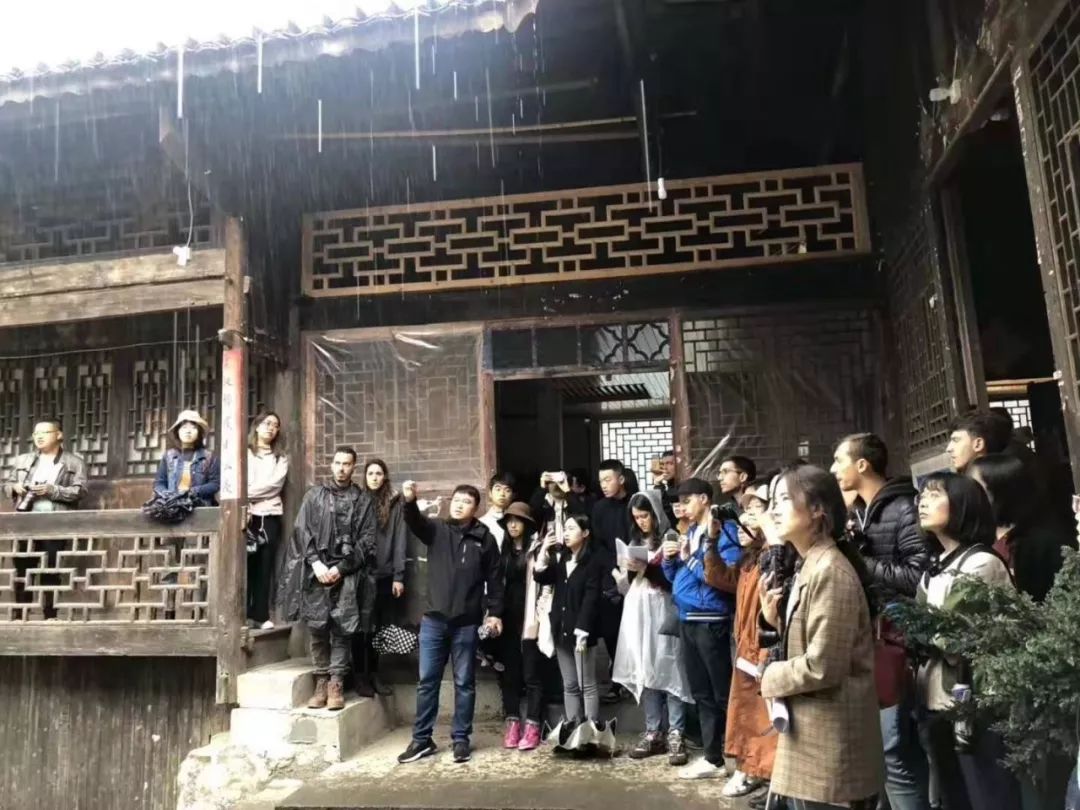
老师现场讲解土家族建筑特征 Teachers explained the characteristics of Tujia architecture on the spot
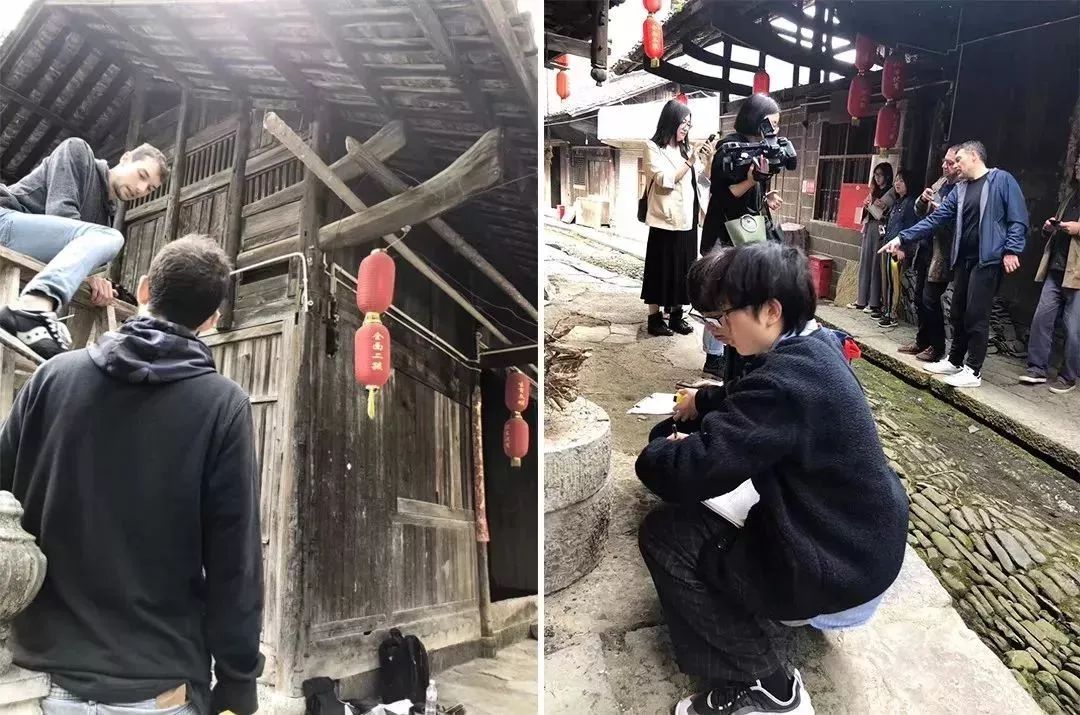
场地测绘与基础调研 Mapping and researching in site, Lianghekou village

与当地村民合影 Photo with local villagers
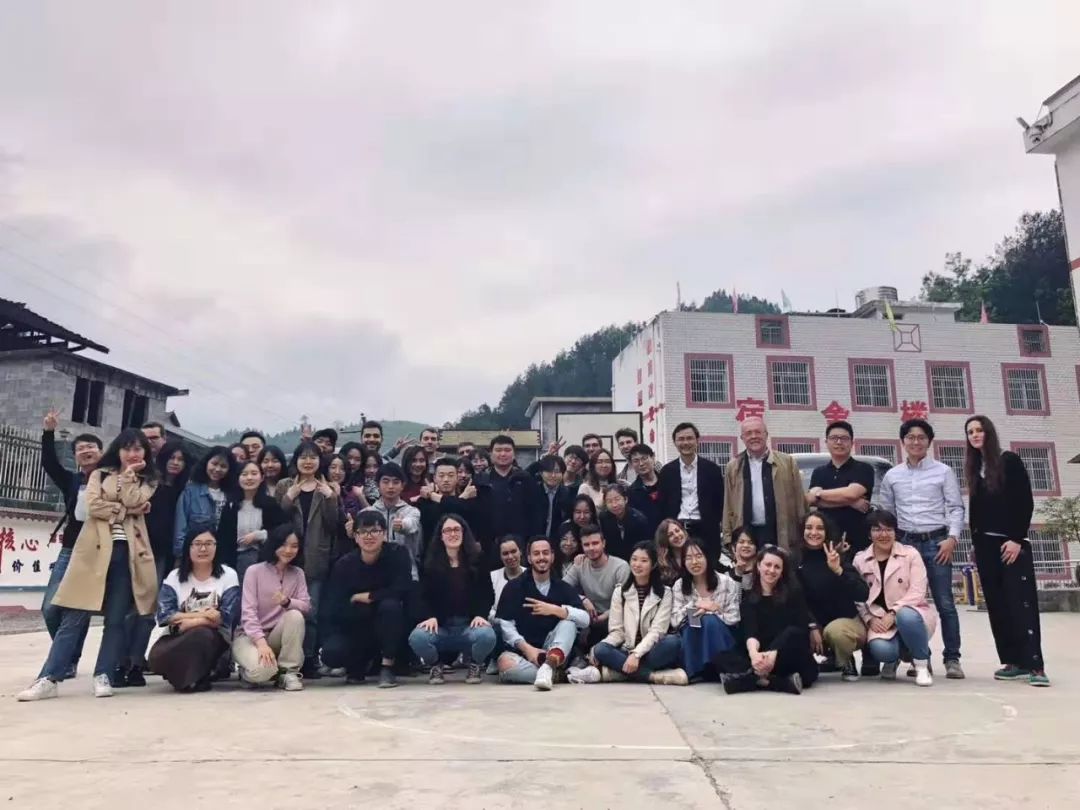
两河口小学现场合影 Photographed at lianghekou primary school
两河口:土家盐道古村的再生|研究生国际四校联合研学 (恩施两河口村前期场地调研与答辩推送链接)
2019.5---6.9 各校独立开展设计教学。
Four universities carry out teaching activities respectively from May to June,2019
2019.6.10---6.13 四校集合在威尼斯建筑大学,进行设计成果的深化、整理与表现。
Deepening the design of the works in IUAV from 10th June to 13rd June, 2019
2019.6.14 威尼斯建筑大学塔夫里厅,课程汇报答辩。
Presentation of the studio design in Tufuri Hall of IUAV on 4th June, 2019
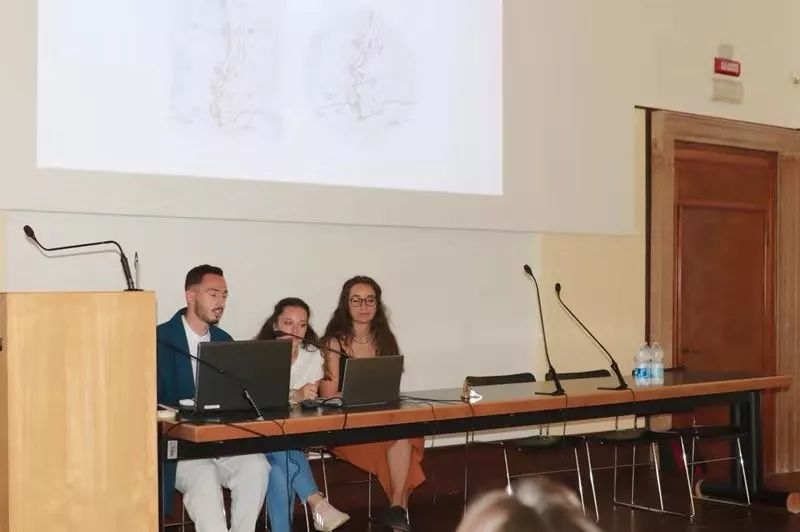
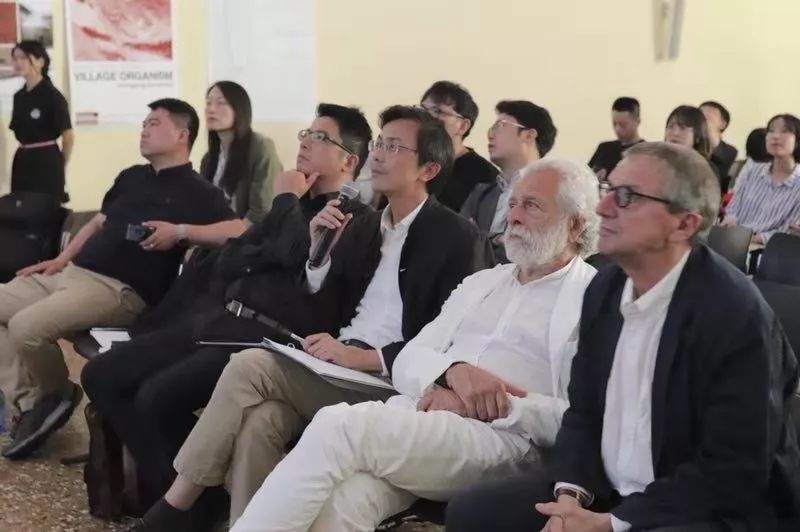
2019.6.17 威尼斯禅宫,两河口工作营设计成果展览
Exhibition of design works ofLianghekou joint studio in Palazzo Zen, Venice
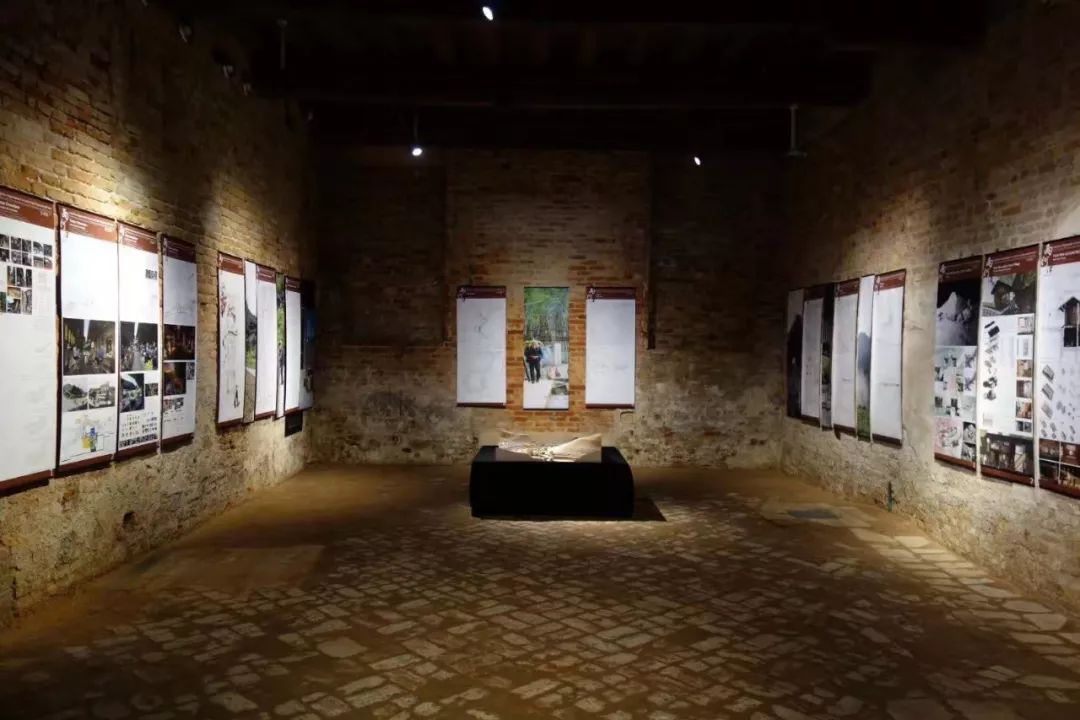
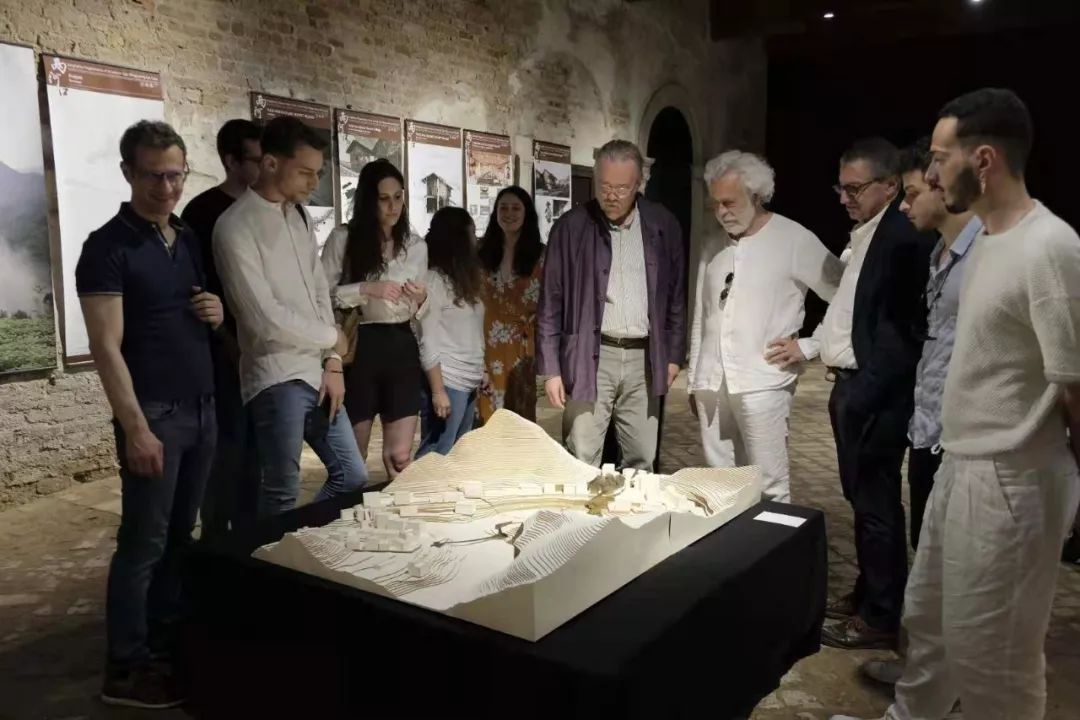
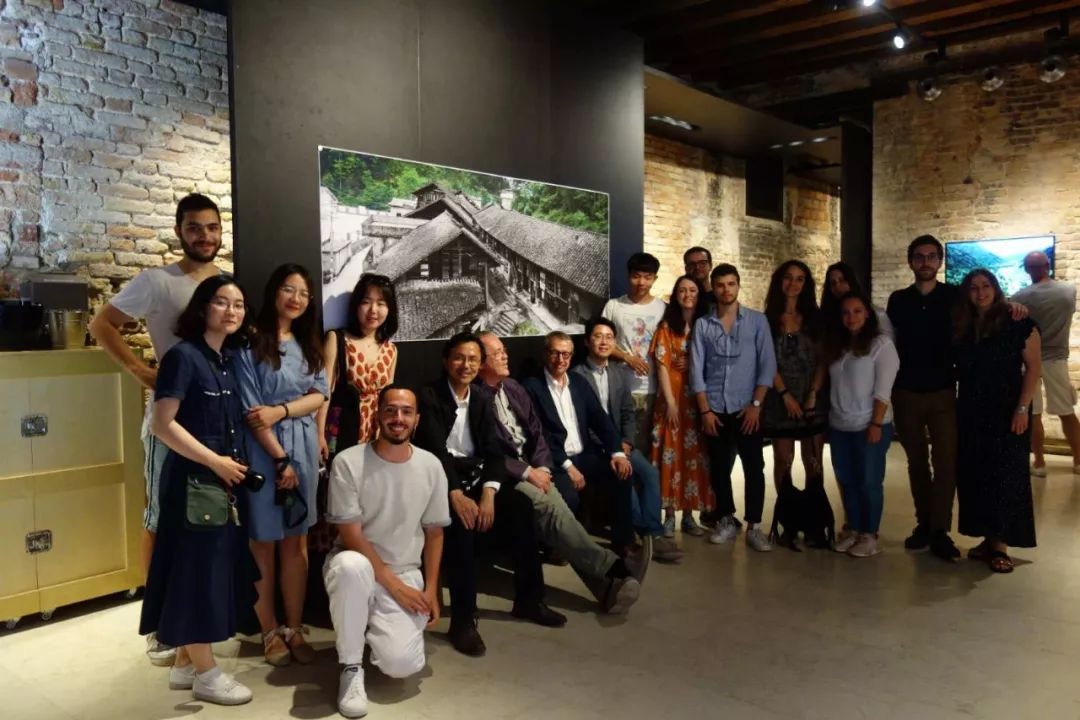
2019.6.25 东南大学研究生设计课课程答辩
Presentation in the Southeast University
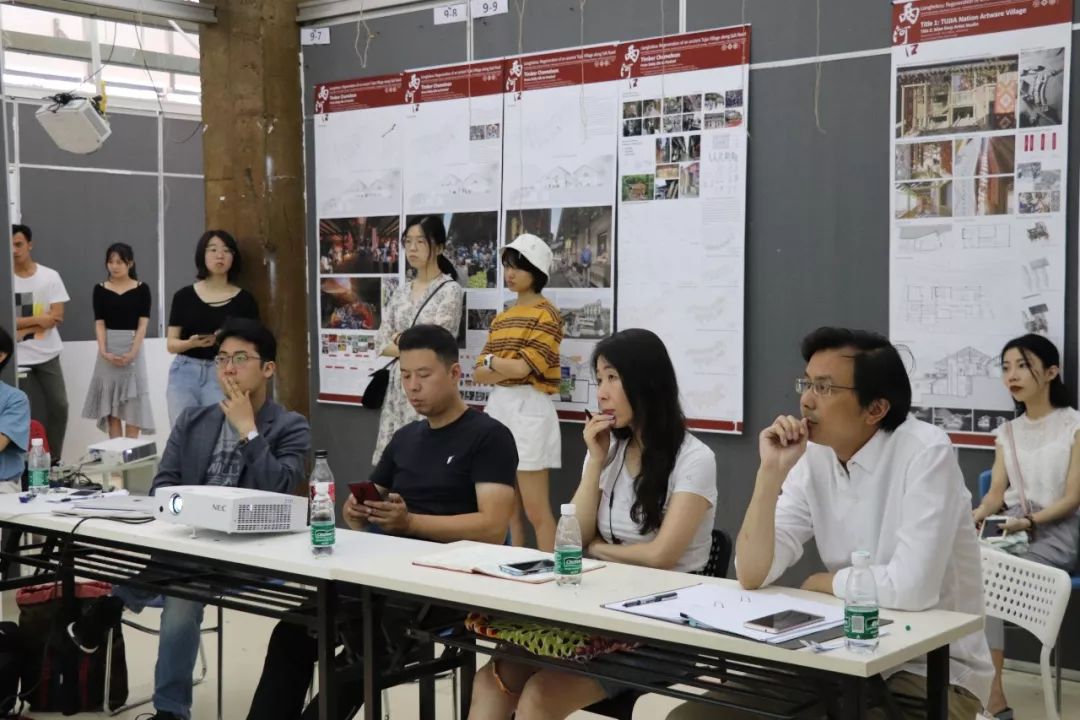
4.设计成果
4.Team Works
G1/SEU Timber Topology: From Daily Life to Festival
木构拓朴:从日常生活到节日庆典
小组成员:隋明明、陈斯予、闫宏燕、李心然(东南大学)
Group members:Sui Mingming, Chen Siyu, Yan Hongyan, Li Xinran (SEU)
中国南方传统的干欄木构建筑,承重体系与围护体系分离,空间和结构呈现出灵活性、可变性和适应性。与中国各地乡土聚落一样,土家族村寨的街道是集体生活的重要场所。干欄木构的可变性与灵活性,使得公共空间展现出迷人的适应性,其形态随着人们的生活方式而改变。现场调研观察到土家族生活的三种典型状态:日常、赶集与庆典。它们需要的公共空间是不同的。该设计研究了两河口村作为一个整体建构体系,其固定与可变的不同组成构成,利用其可拆装的构造方式,以一个结构体系的拓朴变形,适应与承载日常生活、乡村集市和节日庆典的不同空间需求。
The traditional stilt-style timber buildingin south China, with the separation of load-bearing system and envelope system,presents flexibility, variability and adaptability in space and structure. As vernaculararchitecture all over China, the streets of Tujia Villages are important placesfor collective life. The changeability and flexibility of stilt-style timber makethe public space show a charming adaptability, whose form changes with people'slifestyle. Three typical states of Tujia life were observed in the fieldinvestigation: daily, fair and celebration. They require different publicspaces. This design studies Lianghekou village as a whole construction system,with its fixed and variable different components. By using its dismountableconstruction mode, the topological deformation of a structural system adapts toand carries different space requirements of daily life, rural market andfestival celebration.
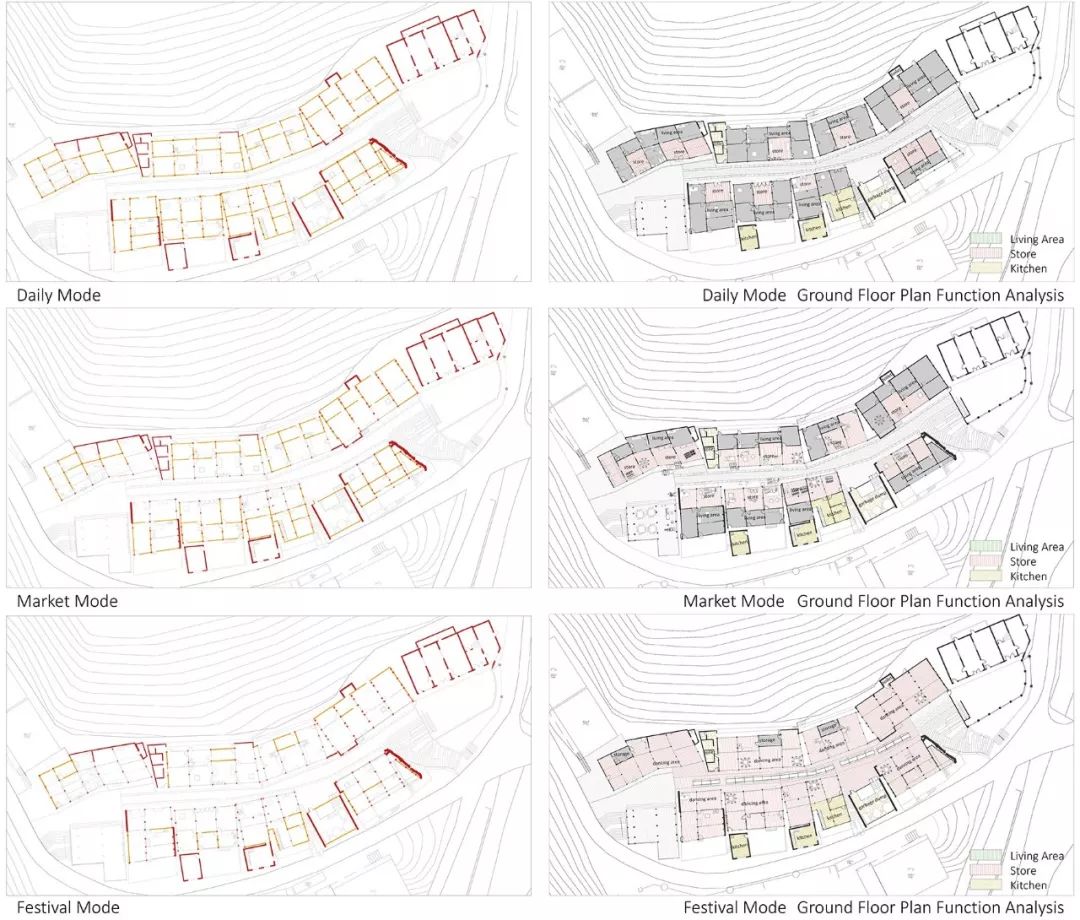
不同模式下老街平面布局 Three layouts of different lifestyles.
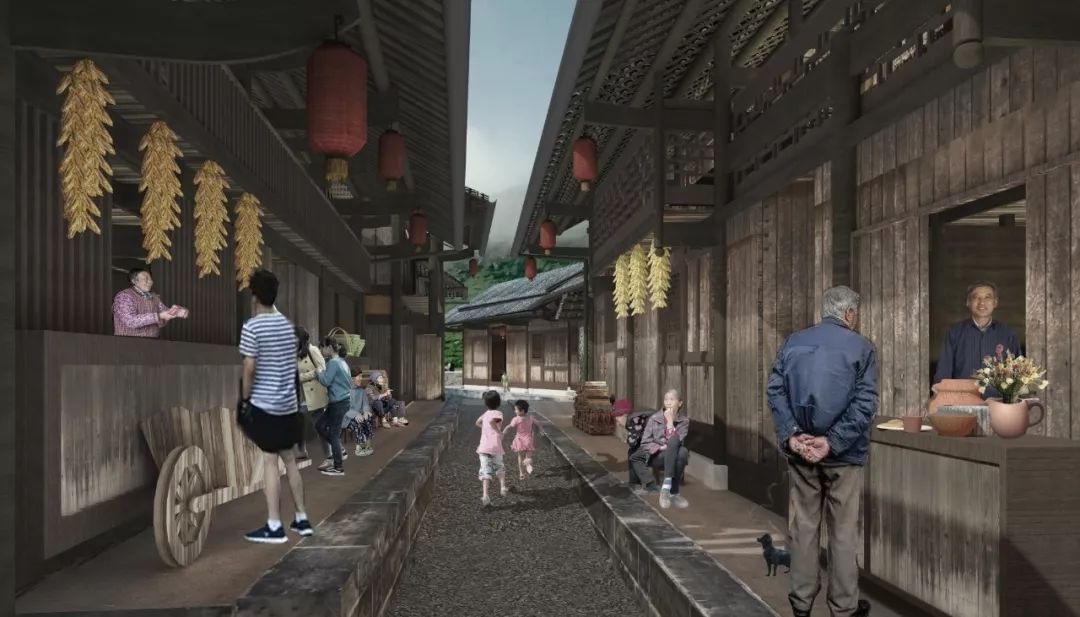
日常生活模式 daily-life model on the street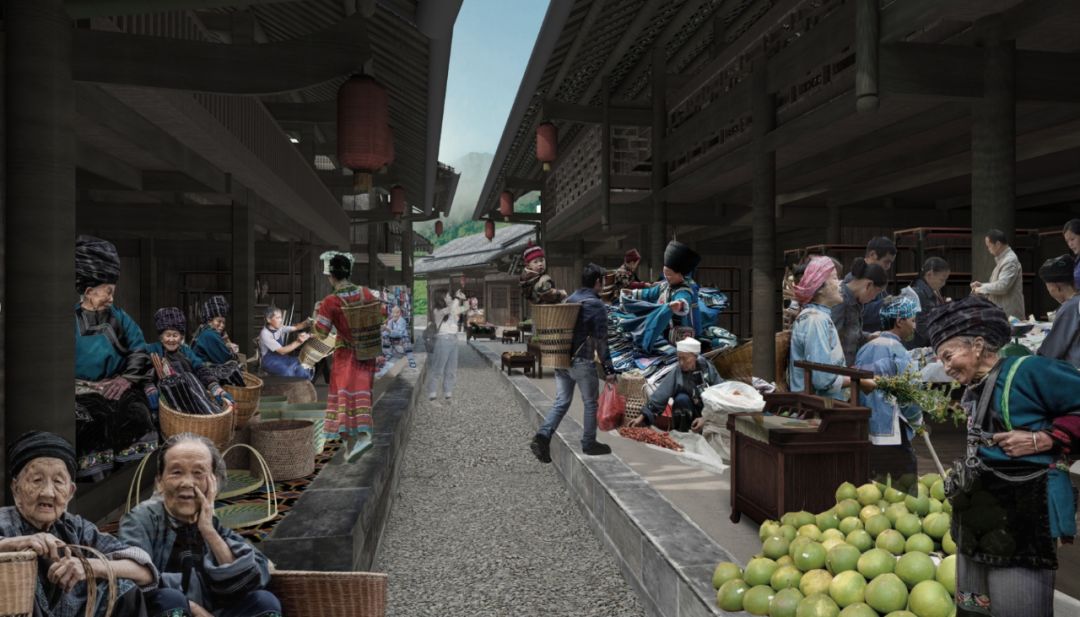
集市场景模式 market-life model on the street
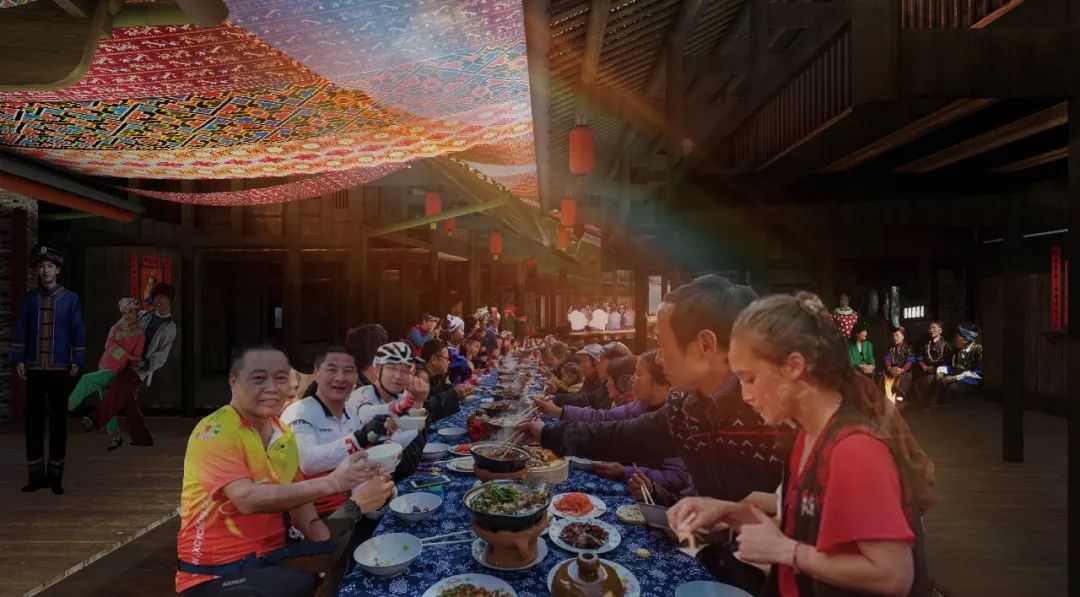
节日庆典模式 festival-life model on the street
G2/SEU:TUJIAFolk Art Village——Reconstructionof Civic Space and Renovation of TypicalStilted House
土家民艺村:两河口村公共空间重塑与典型民居改造
小组成员:徐涵、马雨萌、王瑢(东南大学)
Group members:Xu Han , Ma Yumeng , Wang Rong(SEU)
设计从两河口村与其所在山谷中九寨的区位关系出发,期望打造一个与周边其他村寨功能互补又独具特色的空间节点以吸引来访者。将挖掘、展示、传承、培训土家族丰富多彩的民族手工艺作为新的功能定位,在唤醒濒临失传的民艺,增强地区文化自信的同时,发展新的展陈、民宿、餐饮接待等服务性产业以激活衰败的古村,引导外出村民重新回乡就业。
老街复兴采用两条策略:一是村庄整体公共空间重塑与品质提升,包括改造村口幼儿园与老街入口的地形空间关系,增加游人与孩童的互动;拆除老街中两栋格格不入的新砖房,以土家吊脚楼特征性木构为原型建造一个敞廊,为村庄提供一个多功能的集会休憩空间;利用老街中一处带有二层敞台的建筑,修建过街楼将周围几栋民居连接起来,整体改造,成为高品质的教育、培训和展示场所。二是在单体建筑层面,对土家族山地特征民居进行适应性改造。其中村口一栋改造为艺术家工作坊,将土家族织锦瑰宝“西兰卡普”的工艺流程与创意产品作为展示主题。设计着重运用光线营造空间氛围,通过置入光井与室外栈台,使得织锦在光影变幻中展现独特魅力,渲染出具有土家民艺特色的空间氛围。
In view of the geographical relationship betweenLianghekou village and nine villages in the valley, the design aims to create aspace with complementary and unique functions with other surrounding villagesto attract visitors. The new functional of inheriting, displaying, and trainingTujia's rich and colorful folk handicrafts can arouse the awareness of traditionaltechniques and enhancing the regional cultural confidence. Combining with newservices such as exhibition, homestay and reception, it will regenerate thedecaying ancient village and attract the original villagers to go back to theirhometown for employment.
Two strategies are adopted for the revivalof site: first, reconstruction and improvement of the quality of overall publicspace, including the reshape of the topographical spatial relationship betweenthe kindergarten at the entrance of the village, so as to increase theinteraction between visitors and children. Demolish two new incompatible brickhouses in the old street, build an open Loggia based on the characteristicwooden structure of Tujia stilted building, and provide a multi-functionalpublic space for the village. A old building with an open terrace is used toconnect several residential buildings around the street and transform into ahigh-quality place for education, training and exhibition. Second, in term ofindividual building, one of the stilt building is transformed into an artist'sworkshop at the entrance of the village, where the technological process andcreative fabric products of Xilan Karp as the theme. The design emphasizes theuse of light by placing the light courtyard and outdoor stack platform tocreate a space atmosphere. The brocade shows its unique charm in the light andshadow changes, rendering a space atmosphere with Tujia folk art.
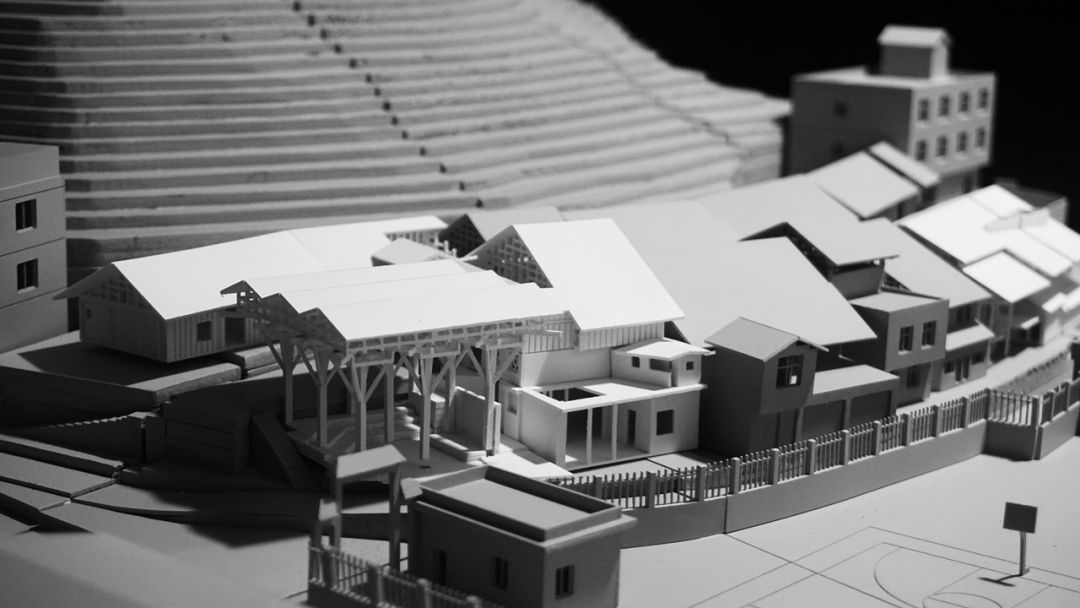
土家凉亭模型The Model of Loggia with public square
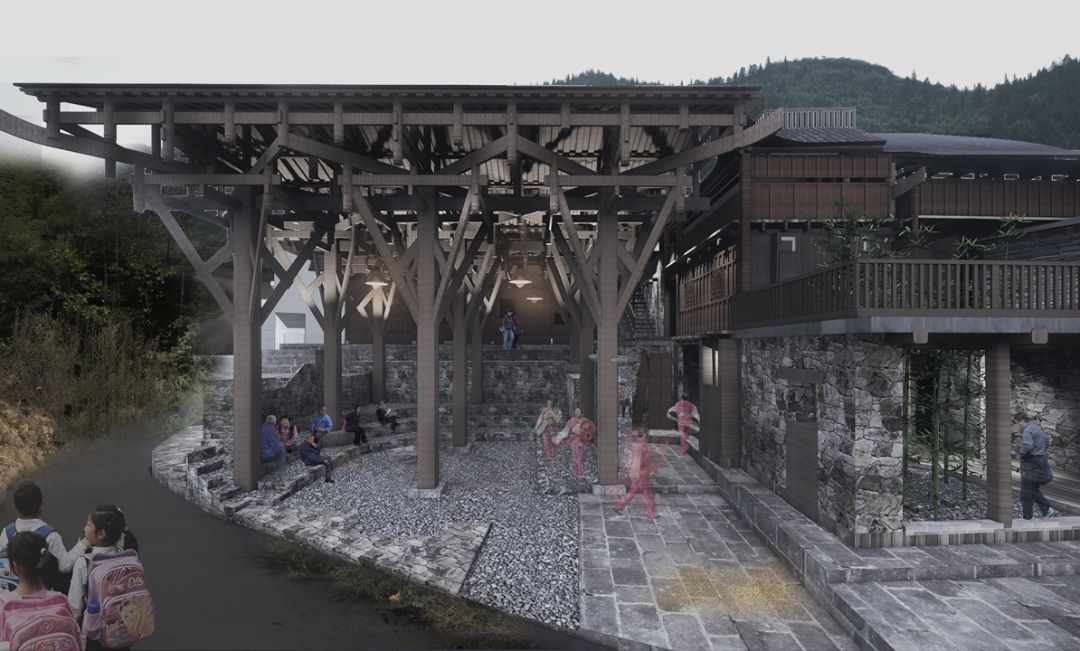
土家凉亭效果图 Rendering of the Tujia Loggia
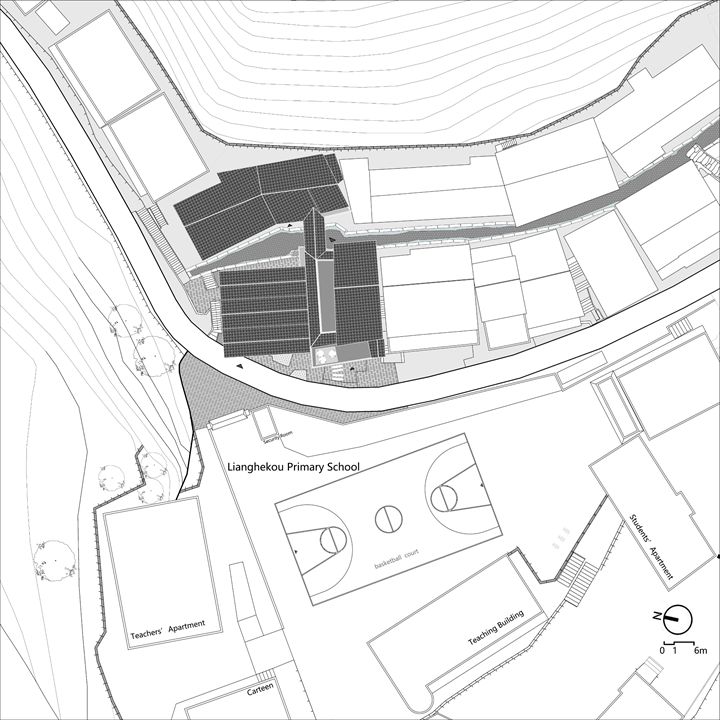
土家民艺葆育中心总平面图 Master plan of the Folk Artware center
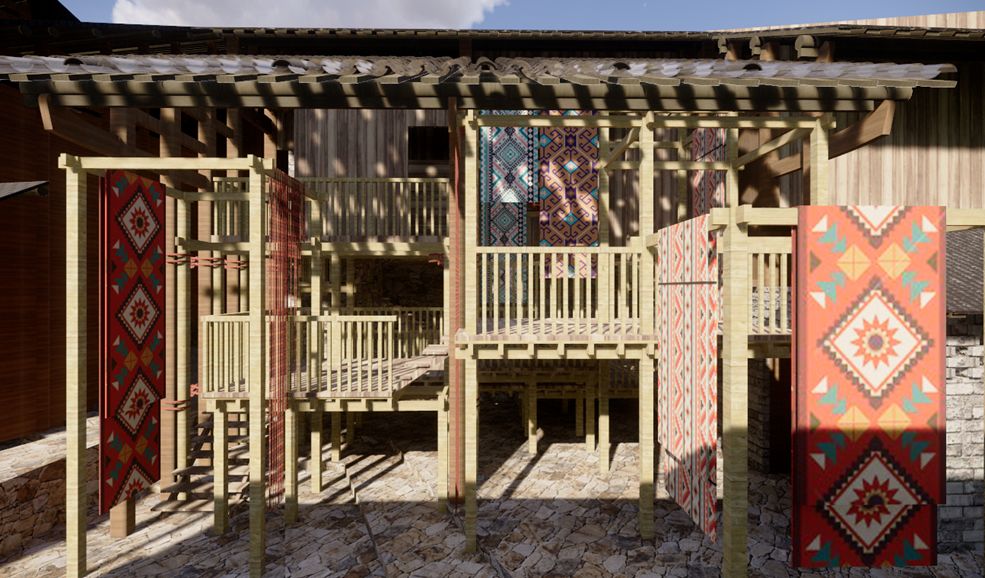
西兰卡普艺术家工坊 Artist's Workshop of Xilan Karp
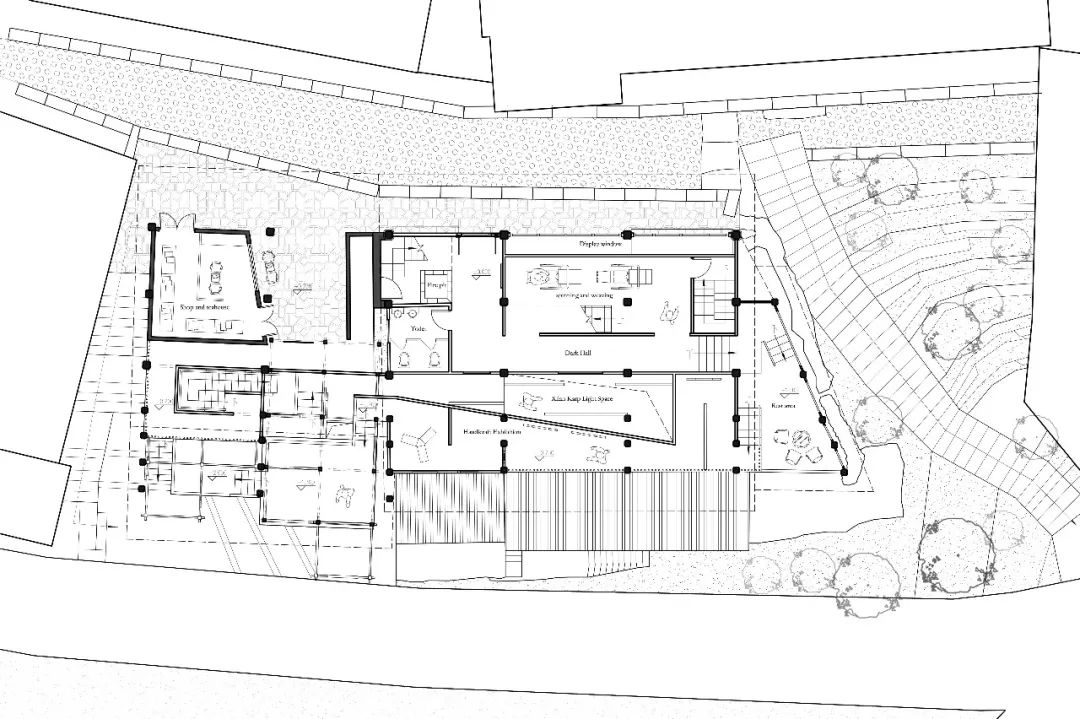
兰卡普工坊平面图 The Plan of the Xilan Karp Workshop
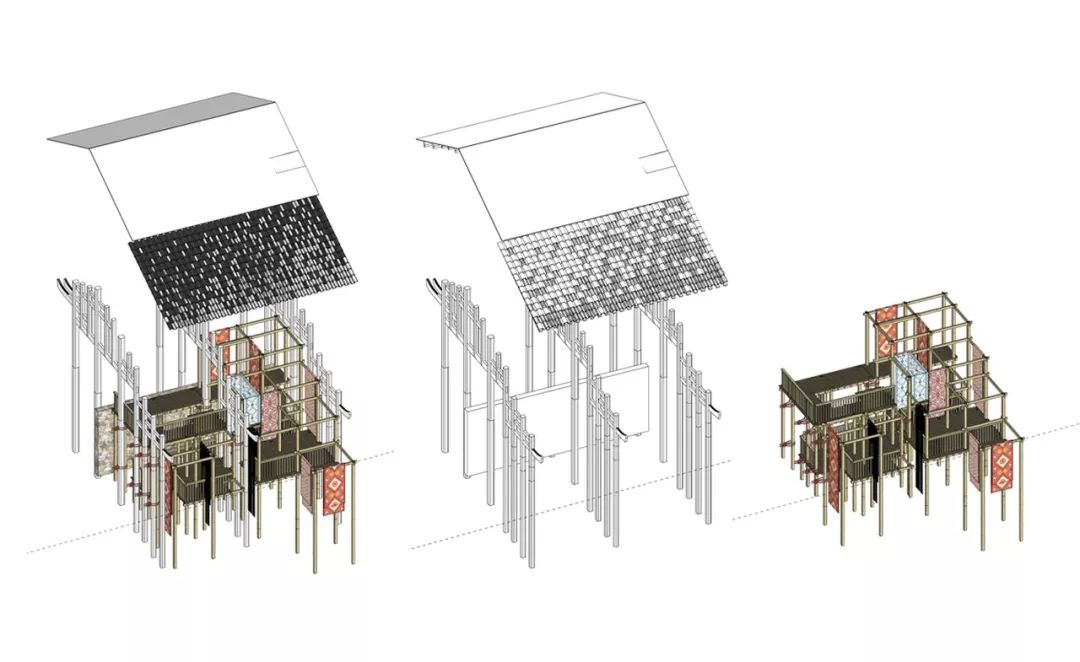
西兰卡普织锦展示室外平台 Outdoor Stack Platform of the Xilan Karp
G3/SEU TUJIA PAN-CULTURE RESORT VILLAGE
土家族泛文化民宿村
小组成员:陈韵玄、沈洁、戈世钊、续爽(东南大学)
Group members:Chen Yunxuan, Shen Jie, Ge Shizhao, Xu Shuang (SEU)
在两河口土家泛博物馆旅游开发的背景下,基于老街自身的区位,赋予其文化主题民宿村的功能,既是对当地旅游服务设施的完善,也给沉睡的村庄重新注入活力。恩施州土家族文化资源丰富,老街所在的盐道曾是土家文化的传播路线。以老街保存完好的空间形态作为物质载体,对当地丰富的土家文化进行转译再现。设计选取了多种代表性的土家特色文化,提取元素进行转化和空间表达而非简单的符号呈现。老街北部入口处两栋建筑作为公共设施,作为日间活动的茶吧和晚间活动的土家酒馆;其余建筑均为承载一种特定土家文化的主题民宿。选取其中4栋建筑进行单体设计,分别是竹编主题民宿、农耕文化主题民宿、傩戏主题民宿,以及有面向街道和室内两个高低不同舞台的土家音乐酒吧。
Under the background of tourismdevelopment of Tujia pan-museum in Lianghekou, based on the location of oldstreet, the function of its cultural theme resort village is endowed, which notonly improves the local tourism service facilities, but also revitalizes thesleepy village. Enshi prefecture is rich in Tujia culture resources. Salt road,where our site is located, was once the transmission route of Tujia culture.Taking the well-preserved spatial form of it as the material carrier, theabundant local Tujia culture is translated and reproduced. The design selects avariety of representative Tujia characteristic culture and extracts elementsfor transformation and spatial expression instead of simple symbolpresentation. The two buildings at the north entrance of old street serve aspublic facilities, serving as a tea bar for daytime activities andTujia tavern for nocturnal entertainments. The rest of the buildings takesymbols of a specific a Tujia culture respectively. Four buildings are selectedfor individual design, namely bamboo-themed b&b, agriculture-themedb&b, Nuo drama themed b&b, and Tujia music bar with two differentstages facing street and indoor.
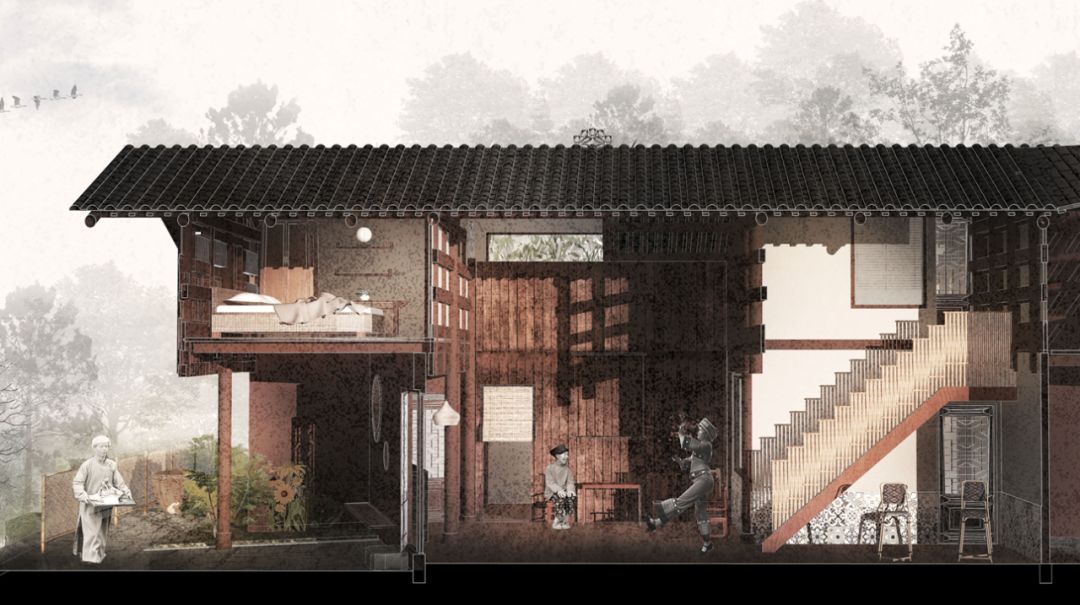
土家竹编主题民宿Bamboo-themed B&B
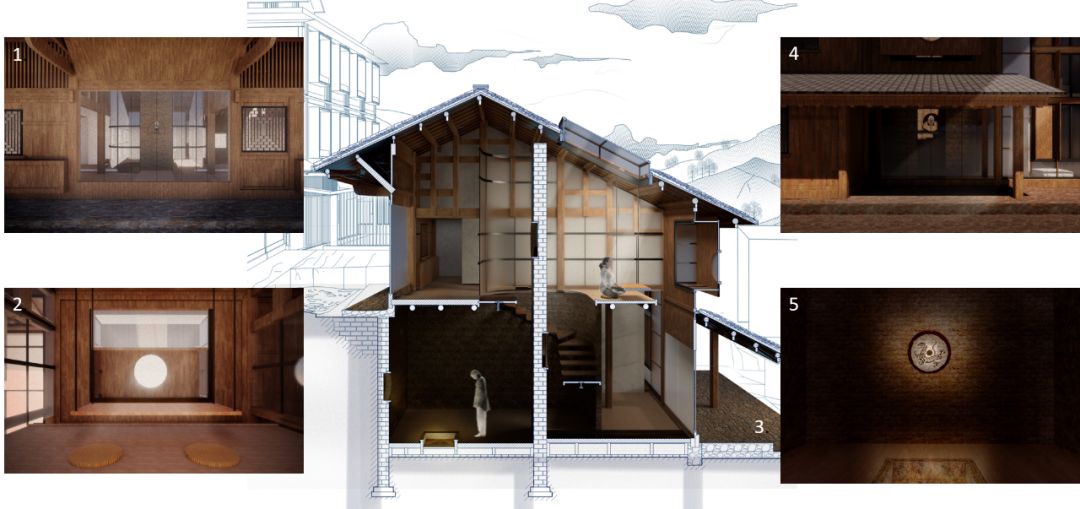
傩戏主题民宿Nuo Drama-themed B&B
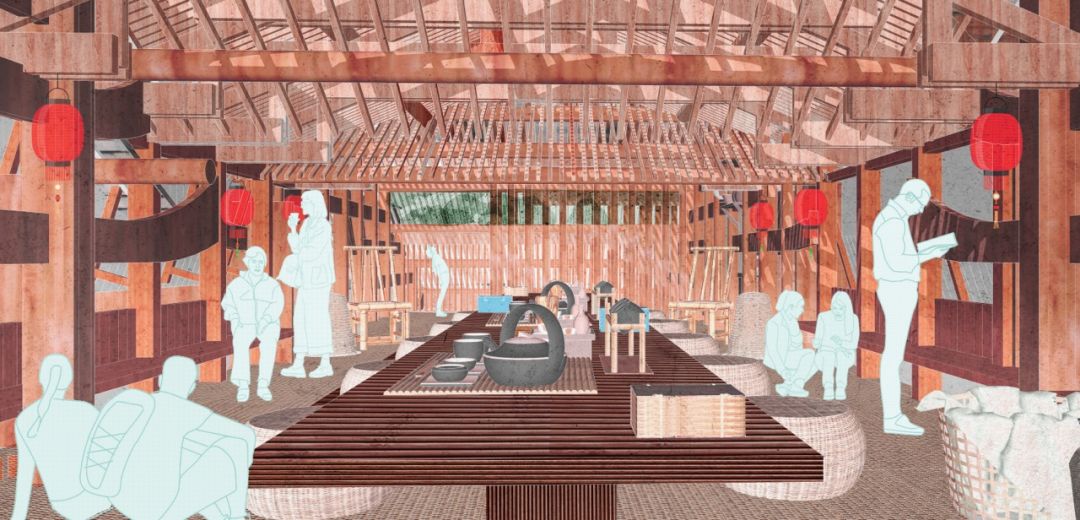
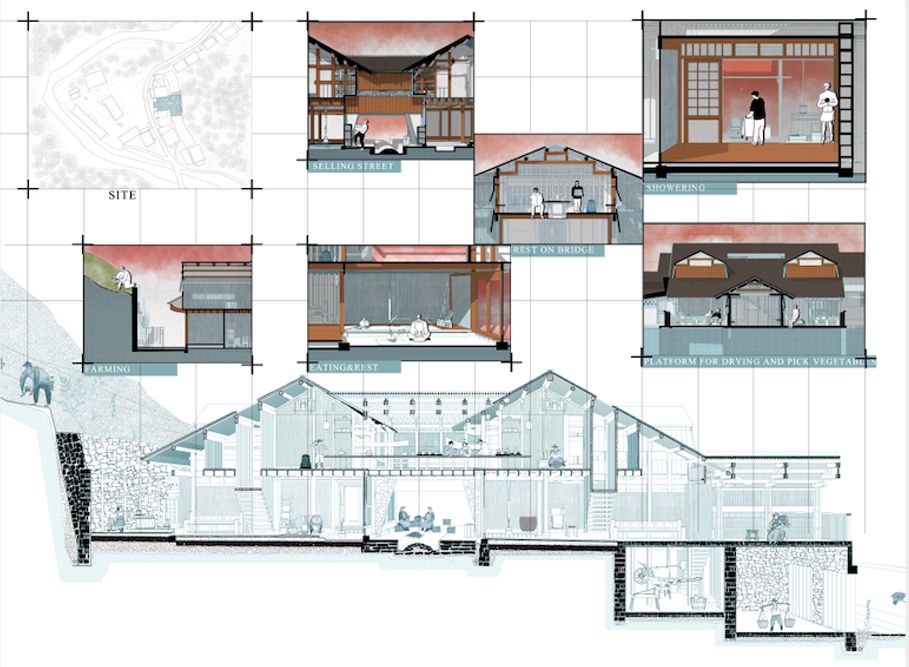
土家民风主题民宿 Tujia Mountain Living-themed B&B
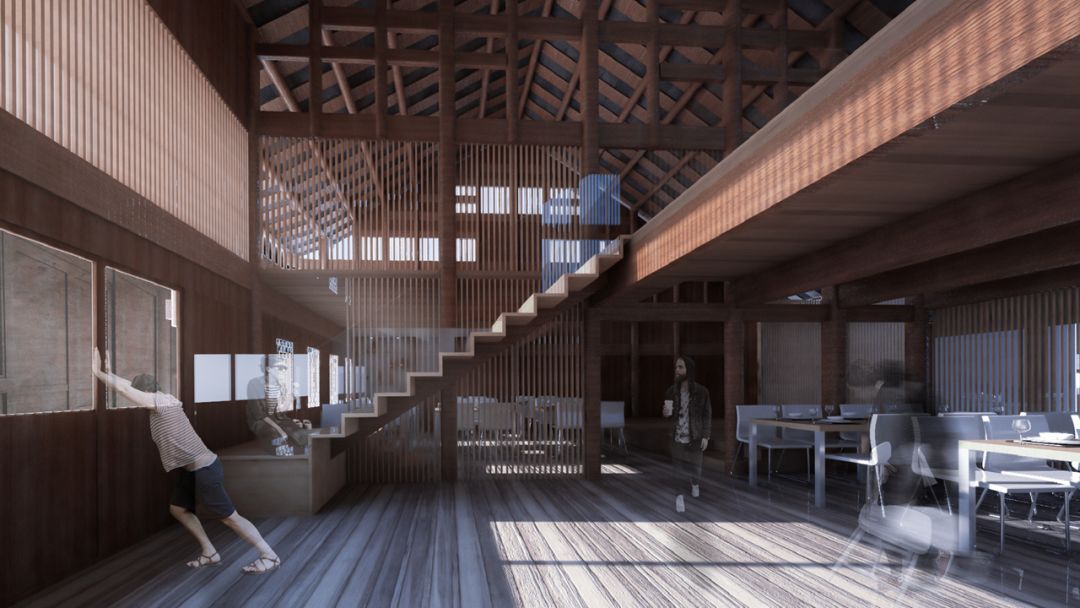
土家族音乐主题餐吧设计 Tujia Music Bar
G4/HUST: Story Market
两河集事
小组成员:魏迪、赵蕊、张师维、王沛泽、彭欣怡(华中科技大学)
Group members:Wei Di, Zhao Rui , Zhang Shiwei, Wang Peize, Peng Xinyi (HUST)
以“两河集事”为主题,一方面表示设计赋予两河口村新的集市功能,另一方面体现了希望更多故事在此发生的愿景。两河口村面临的问题体现为“拆”与“留”的矛盾,我们选择保留老街转变功能来面对这一问题,“集事”成为解决问题的突破口。通过对聚落、街道、建筑以及行为模式四个方面进行分析评估,提取了老街的七个原型,进行拆分与重组。老街一层作为集市,满足当地居民日常购物与赶集的需求,同时也为游客提供文化体验与购物的场所。拆除一层部分墙体,保留火塘空间并进行功能转译。二层则作为盐道历史展览空间,植入廊道串联观展流线。除此之外选择三处节点,分别定义为摆手坝、拾忆亭和思阅馆,植入全新功能为居民与游客提供服务。利用两河口老街,我们尝试着创造一个匀质空间,一个可以提供各种事件发生的场所,在这里可能会上演居民与游客的故事、现代与传统的故事以及民族融合的故事……
The theme of “Story Market ", on the one hand, indicates that the design addthe new market function of Lianghekou village, on the other hand, it reflectsthe vision of wishing more stories happen here. The problem of Lianghekouvillage is the contradiction between "demolition" and “preservation”.We choose to retain the transformation function of old street to confront thisproblem, and events becomes the breakthrough to solve the problem. Through theanalysis and evaluation of settlements, streets, buildings and behaviorpatterns, seven prototypes of old streets are extracted, which are divided andreorganized. The ground floor of the old street is used as a market to meet thedaily needs of local residents for shopping. Meanwhile, it also provides aplace for tourists to have cultural experience. Removing parts of the wall onthe first floor to preserve the fireplace space and carry out functionaltranslation. The second floor is used as the salt road historical exhibitionspace, and the corridor is implanted to connect the exhibition route. Inaddition, three nodes are selected, which are respectively defined aswaving-hand Dam, Shiyi Pavilion and Siyue Hall. New functions are implanted toprovide services for residents and tourists. we try to create a homogeneousspace, a place where various events can take place, where stories of residentsand tourists, stories of modern and traditional, and stories of ethnicintegration can be staged...
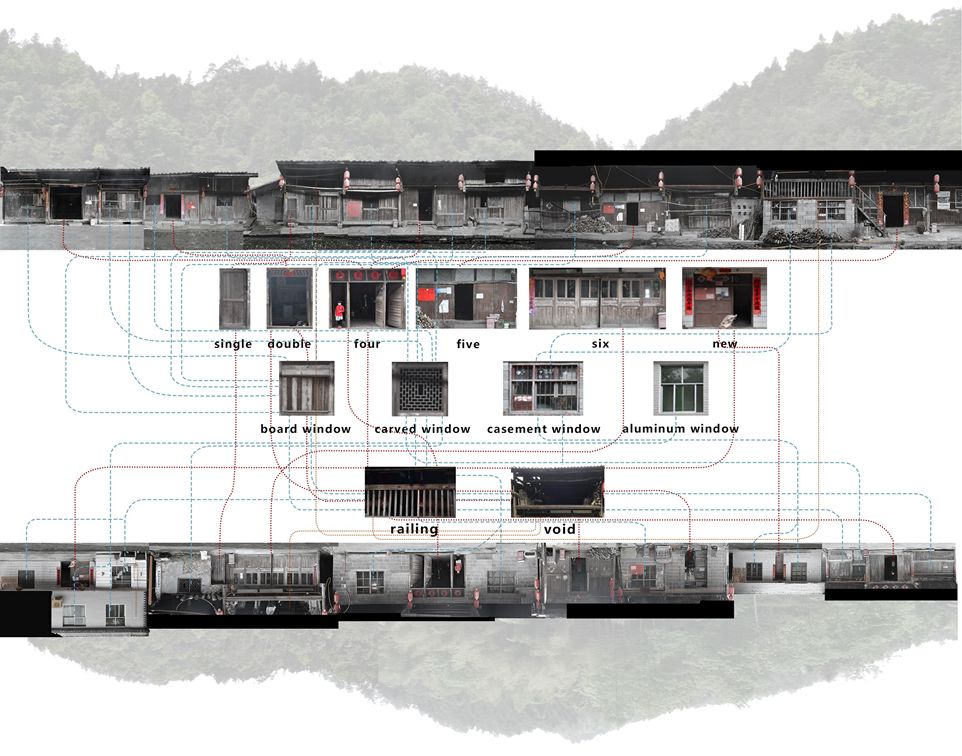
老街的建筑要素提取 Elementsanalysis in Lianghekou Old street
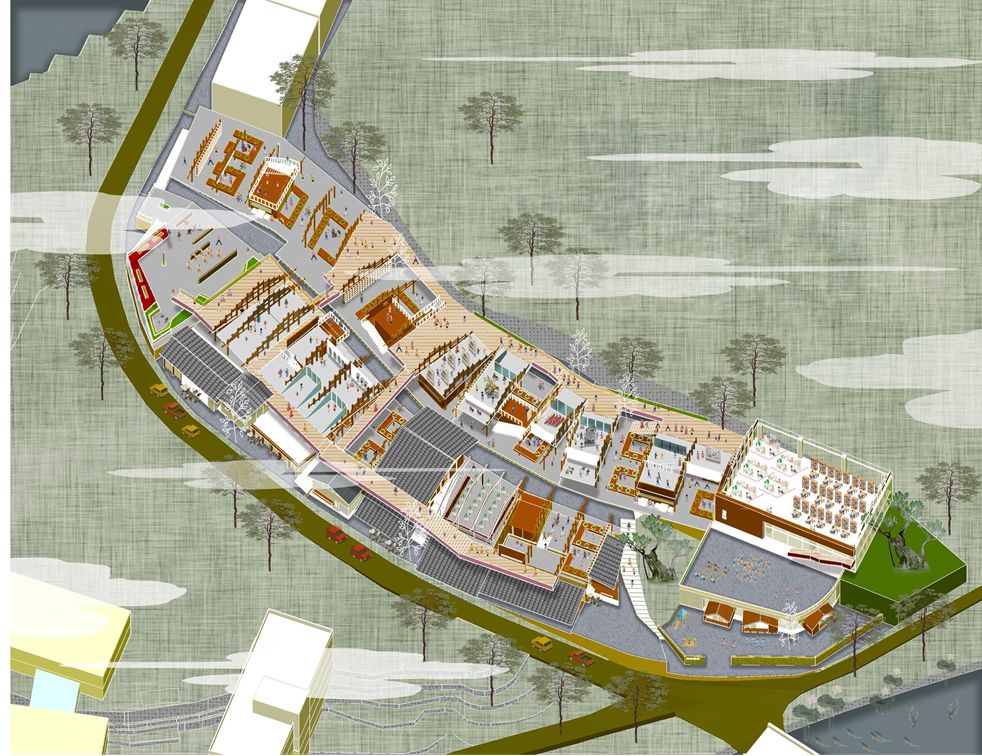
两河集市畅想 The vision of the Story Market
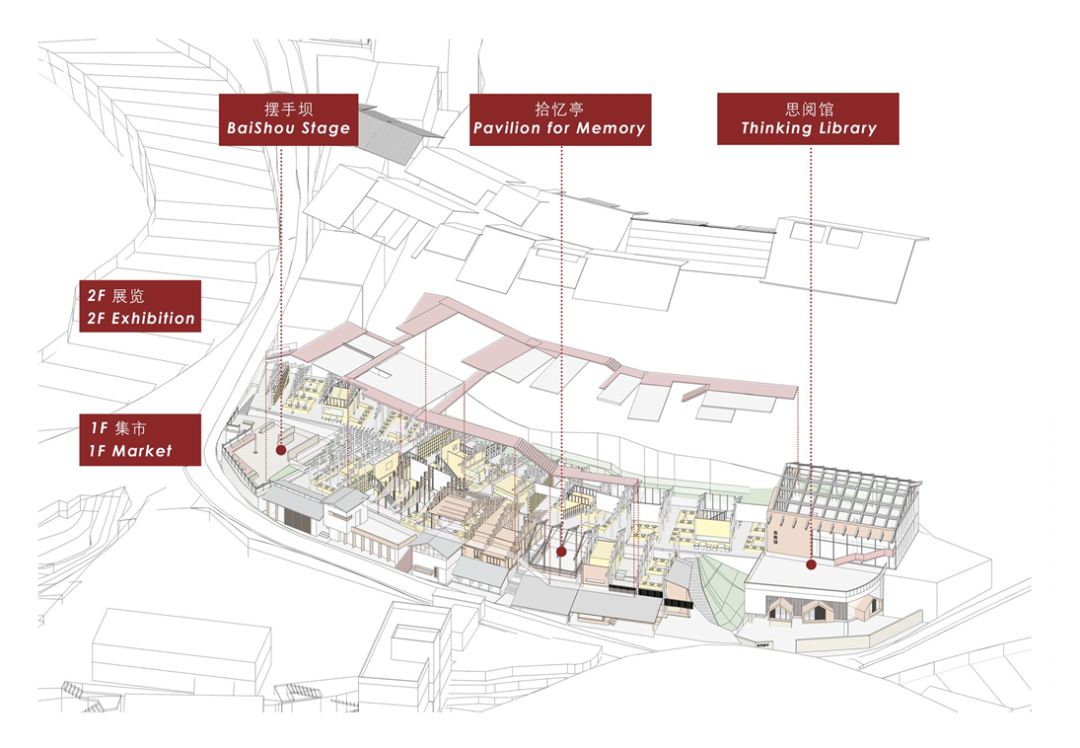
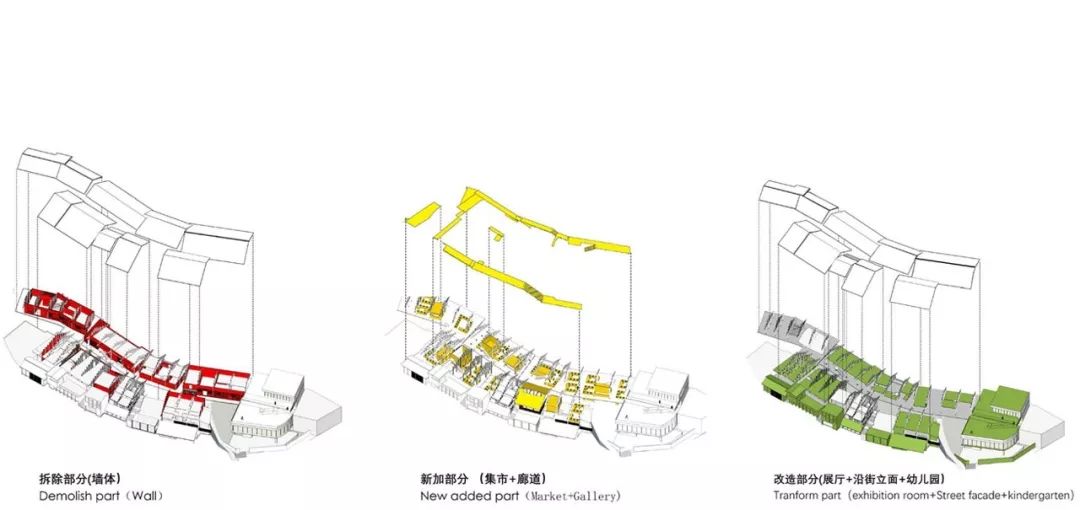 两河集市畅想 The vision of the Story Market
两河集市畅想 The vision of the Story Market
G5/HUST: "Particle Fun"——Regeneration of LianghekouSalt Road Ancient Street
“言(盐)·趣”——两河口盐道古街复兴
小组成员:王宁、何仕轩、田淑颖、(华中科技大学) 刘文玉(湖北美术学院)、王长曦(湖北美术学院)
Group members:Wang Ning, He Shixuan, Tian Shuying, Liu Wenyu,Wang Changxi (HUST、HIFA)
设计立足于保护、活化古村落,创造自身造血能力为前提,结合提升当地居民自身文化认同与延续土家文化而融入土家木工、竹编、西兰卡普等丰富的特色民艺,将村落定位为有文化保护、孕育功能的生态博物馆,并融入整个彭家九寨“泛博物馆”体系之内来达到活化古街的效果。
转译“盐”颗粒状的特性,以临街的汇聚各种活动的家庭火塘为核心元素,拆除其外墙,直接将其与古街空间相连,并置入公共的社会活动。火塘作为一系列颗粒状的激活因子,重新在老街发挥新的作用。此外,为强调土家聚落“山房田水”空间格局,清除了场地内影响建筑风貌的新建和加建部分,新置入一个社区图书馆,增强文化属性,同时开辟后山和临水游览路径,中间加以联通,形成网状空间布局。
通过这些活化策略,人们在盐道古街生态博物馆安居乐业,大量的交流言语与丰富有趣的场地空间交相辉映,实现了盐道古街的复兴,故名曰“言·趣”。
Design based on the protection and regenerationof ancient villages to improve the cultural identity and cognition of localresidents about Tujia culture including wooden craft, bamboo weaving, and ZilanKarp of folk art. Design may be defined as a culture ecological museumintegrated into the whole PengJia nine villages Pan museum to achieve the aimof regeneration of ancient street.
The granular character of "salt"is translated. Taking the family fire pot facing the street as the coreelement, the outer wall is demolished and connected to the outdoor space wherepublic social activities happened. As a series of activators, fire pot plays a newrole. In order to emphasize the spatial pattern of "buildings in hillswith rivers" in Tujia culture. A community library was added to enhancethe cultural attribute. Meanwhile, the tour paths between the back mountainsand the water were opened up, which were connected in the middle to form anetwork spatial layout.
Through these activation strategies, peoplelive and work along salt road in ancient street ecological museum with a largenumber of sceneries of communicating and interesting space mixed up, therevival of Lianghekou village called "dialogue · interest".
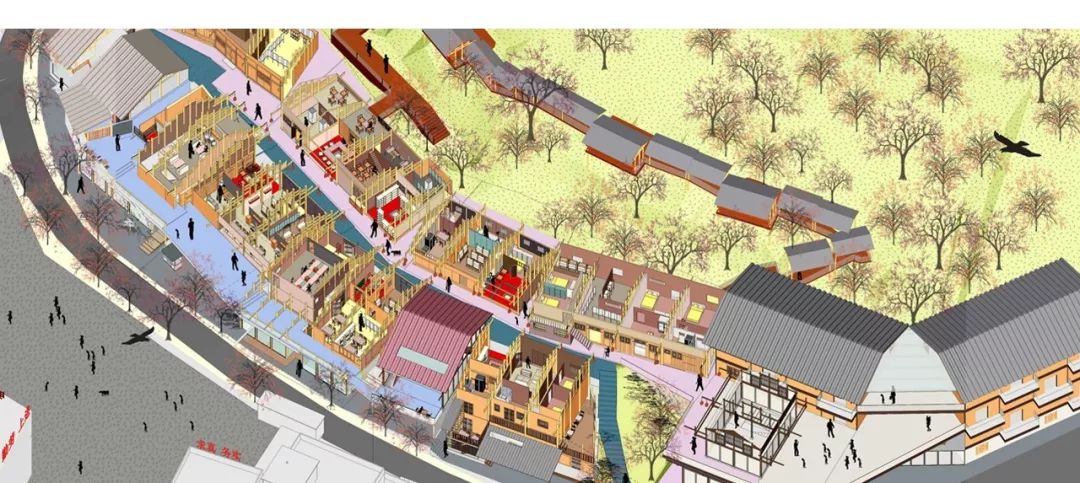
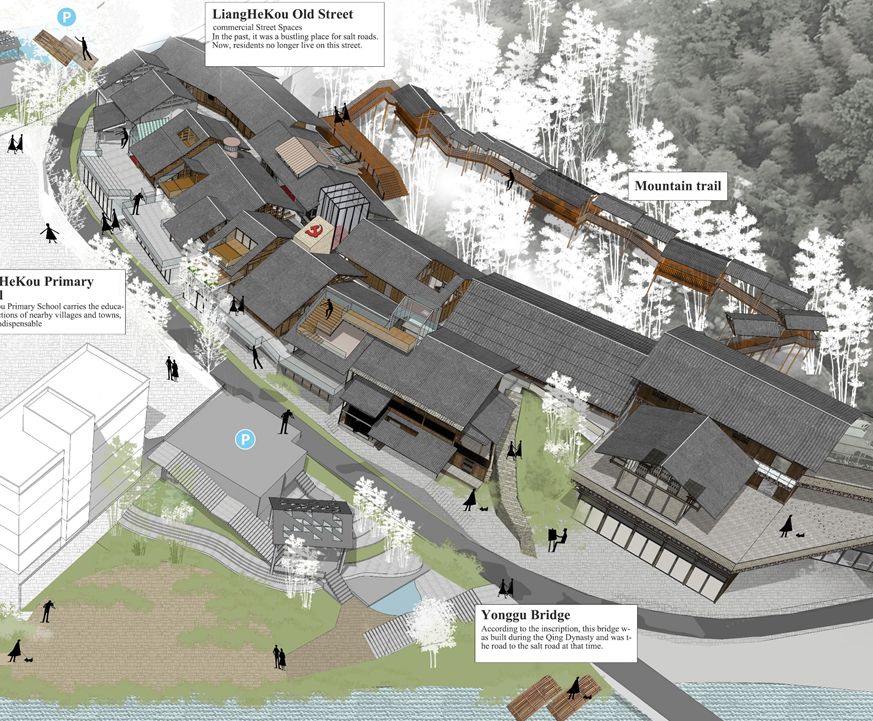
老街改造后场景畅想 The vision of the Old Street after reburfished
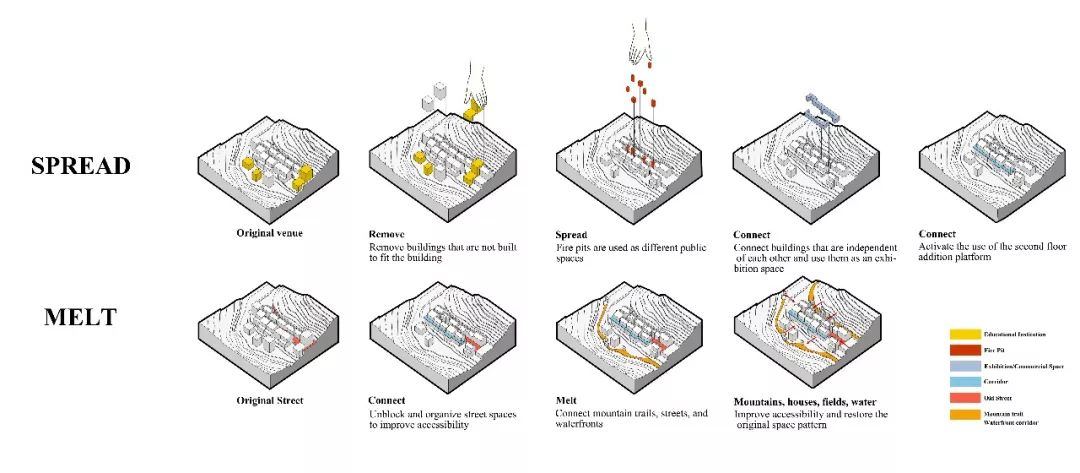
介入老街的改造策略 The strategies of involvement in the Old Street
G6/IUAV: Basamento Continuo
两河口:盐道古村再生(中期阶段)
Group members:G. Bordin, I. Bottino, D.Burro, D. Bruneri,A. Canton, E. Cielo, M. D'Altoè, A. Marsella,T.Ortolan, G. Rettore, I. Rosolen,A. Sparapan, A. Zen(威尼斯建筑大学 IUAV)
在较大尺度的整体规划层面,设计使两河口成为连接山谷中不同村庄的枢纽,成为盐路沿线旅游线路中通往不同特色村寨的起点。这些村庄将由一条公交线路和自行车/步行线路连接起来。在入口处设置换乘停车,有助于控制区域的交通流量。两河口村将有一个通向老街新入口,一座桥以及不同类型的台阶和坡道将村庄与河流两岸连接起来。
老街中所有新建和损毁的部分将被移除,沿马路的底层,将包含一个新的服务中心。底层和连接通道将采用当地材料和工艺,如砖石和木材。历史建筑和新建筑的功能是彼此混合的,以提供带富有当地文化特色的酒店、住宿、商业和娱乐等多种服务。
On a large scale, in terms of urban planning,the aim was to make Lianghekou part of a route which links different villageslocated along the same valley. Lianghekou will be the starting point of a notmass tourism route along the Salt Road and every village will preserve itspeculiarities. The villages will be linked by a bus line and cycling/pedestrianlines. A change over parking at the entrances of this route will prevent theentry of unsuitable car flows for that kind of roads.
All the most recent and decadent addictionswill be removed and a new basement, at the lowest level of the ancient village infront of the driveway, will contain the new design services blocks and flows.The basement and the architectural elements of the path will have local andrecovery materials such as tiles and blocks. The new functions for both historicaland new buildings will be different and mixed in order to provide for variouskinds of usability: hospitality, residential, commercial and for recreation,but in compliance with the local tradition.
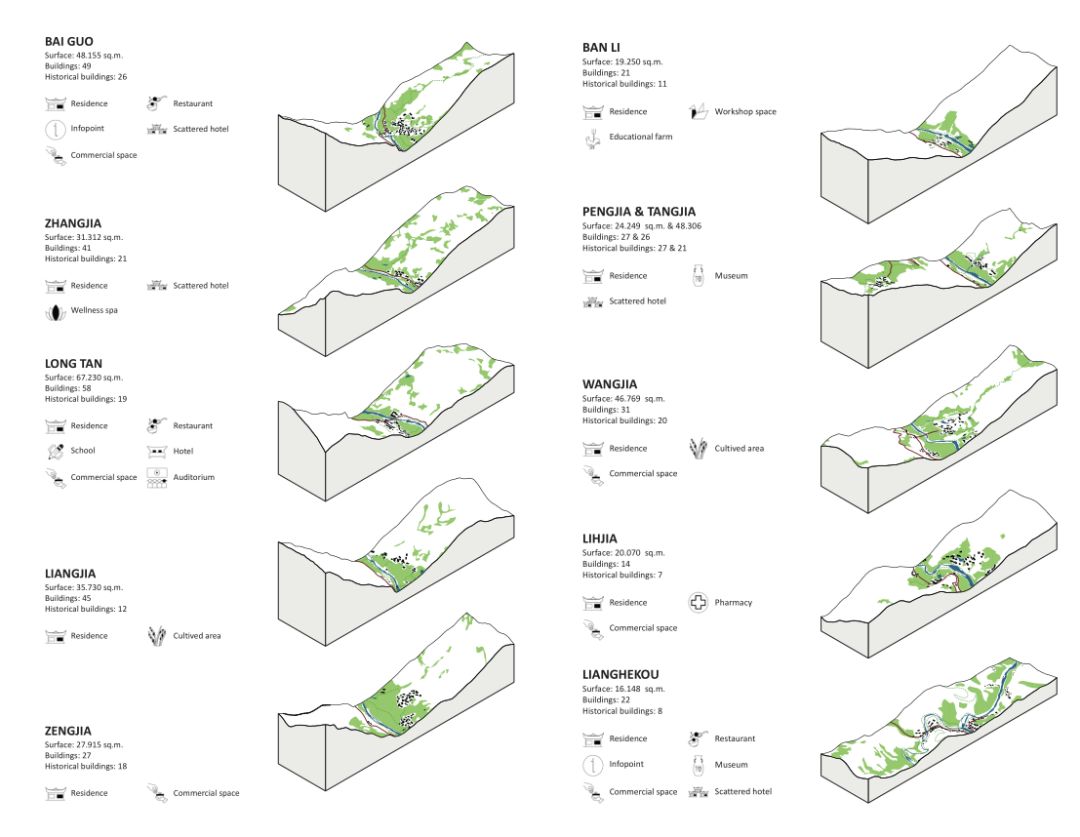
两河口与九寨的地理特征 Characteristics of typologyof Lianghekou and other nine villages in the Valley
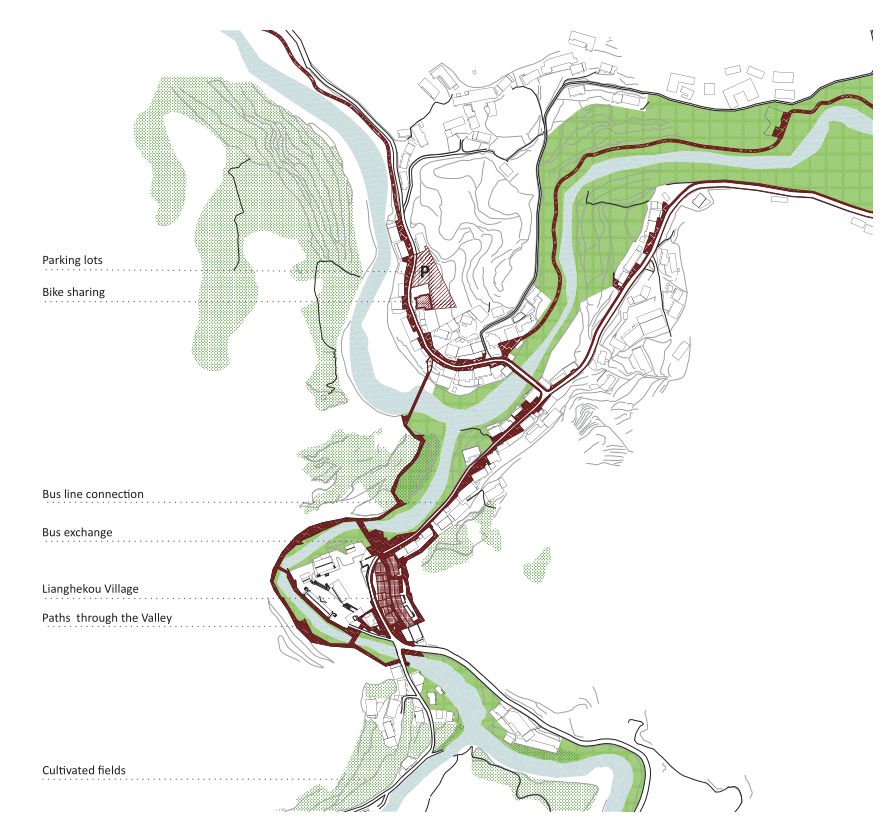
两河口村整体规划 The planning of the Lianghekou village
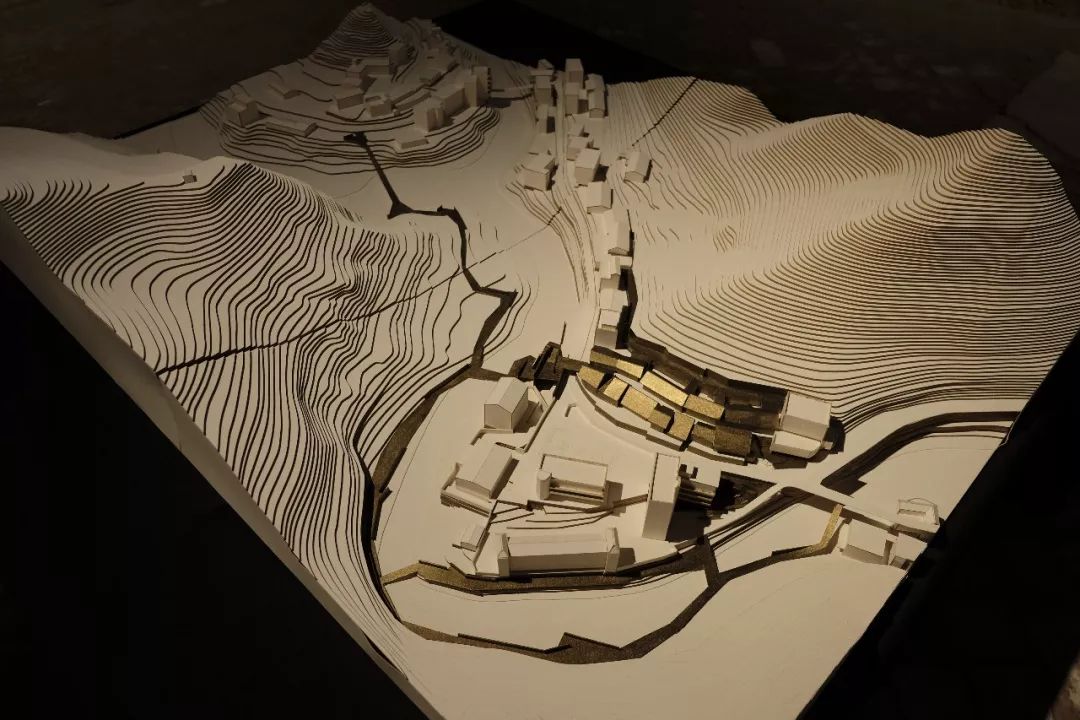
设计方案模型 The Model of project
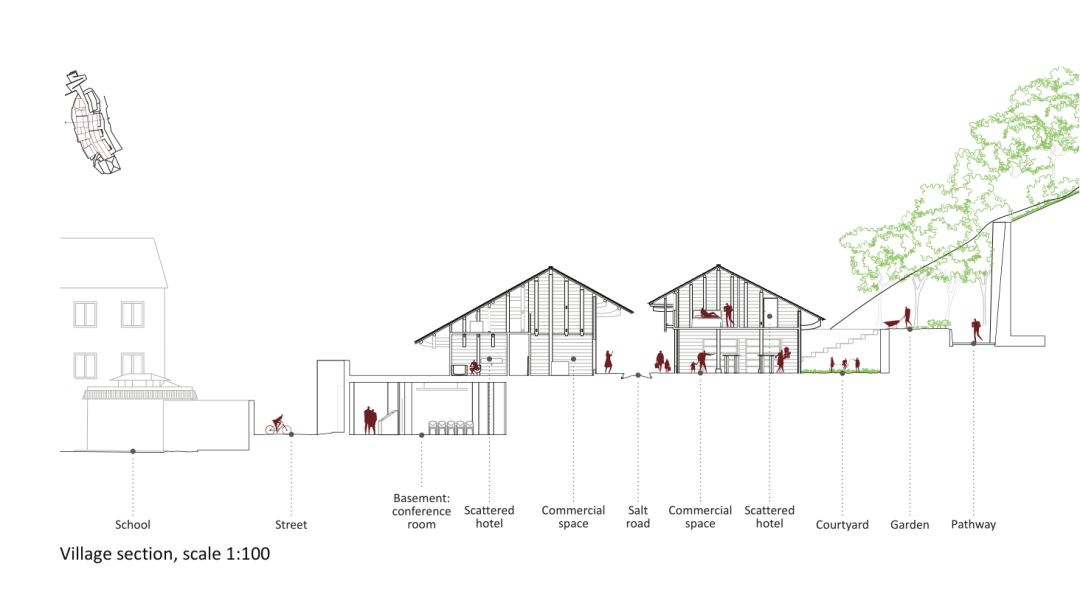
场地方案剖面图 The section drawing of project
G7/CQU: " Village Organism "——History, Healthy andHarmony
“乡村生命体”—— 历史| 健康 | 和谐
小组成员:顾明睿、阳蕊、李晨、吴霜、黄金静、戴连婕(重庆大学)
Group members:Gu Mingrui,Yang Rui,Li Chen,Wu Shuang,Huang Jinjing,Dai Lianjie (CQU)
针对村庄现存问题,通过对村民5分钟、10分钟、15分钟活动圈的分析,我们将老街的一期建设定位为村民活动中心。在规划、建筑、景观三方面分别提出“空间处方”,意图用老街这个“乡村生命体”“医治”两河口村的“伤病”。在规划上,我们分析出人口结构不平衡、村庄空置、文化生活匮乏、产业结构单一这四方面主要矛盾,所以我们一方面运用空间句法对场地交通进行重新梳理,另一方面置入茶馆、文具店、体检中心、民宿、图书馆、体验馆等多种功能。在景观上,由于原老街景观单一,于是选取两轴(新街、后山)三节点(南入口、北入口、后山)进行景观优化。在建筑上,对12栋房子建立档案卡,评估出3栋最具改造潜力的建筑进行改造。古建筑1位于整条老街的端头,设计重新梳理了高差,利用小的错层和楼梯制造更多趣味空间,希望通过历史场景的叠加,让静止的建筑表演起来;古建筑2依靠后山,设计在保留并优化原有村民居住功能的同时,将闲置空间改造为民宿,希望通过平静的介入让建筑功能和谐演变;现代建筑3也位于整条老街的端头同时面对小学,设计置入老年健康、老年活动、儿童餐饮等主题功能,保留古建筑的整体结构,再现传统手工艺的同时,也为功能新生提供可能。
The design theme of our group is “VillageOrganism”. For village of existing problems, and through analysis of thevillagers’ 5 min, 10 min, 15 min activity zones andLianghekou village master planning, the first phase of construction positioningfor Old street is the villagers activity center. We put forward "spaceprescriptions “respectively in the planning, construction and landscape thesethree aspects, expecting the " village organism " "cures"the "injury" of Lianghekou Village. In terms of architecture, 12houses were built with file cards, and three buildings with the most potential forinnovation were evaluated for renovation. Traditional architecture 1 is locatedat the end of the whole old street. The design reorganizes the height differenceand makes use of small splitter floors and stairs to create more interestingspace. It hopes to make the static architecture perform through the overlay ofhistorical scenes; Traditional architecture 2 relies on the back mountains.While retaining and optimizing the original residential functions of villagers,the design upgrades the spare space into a homestay, hoping to make the building function evolve harmoniously through peaceful intervention.
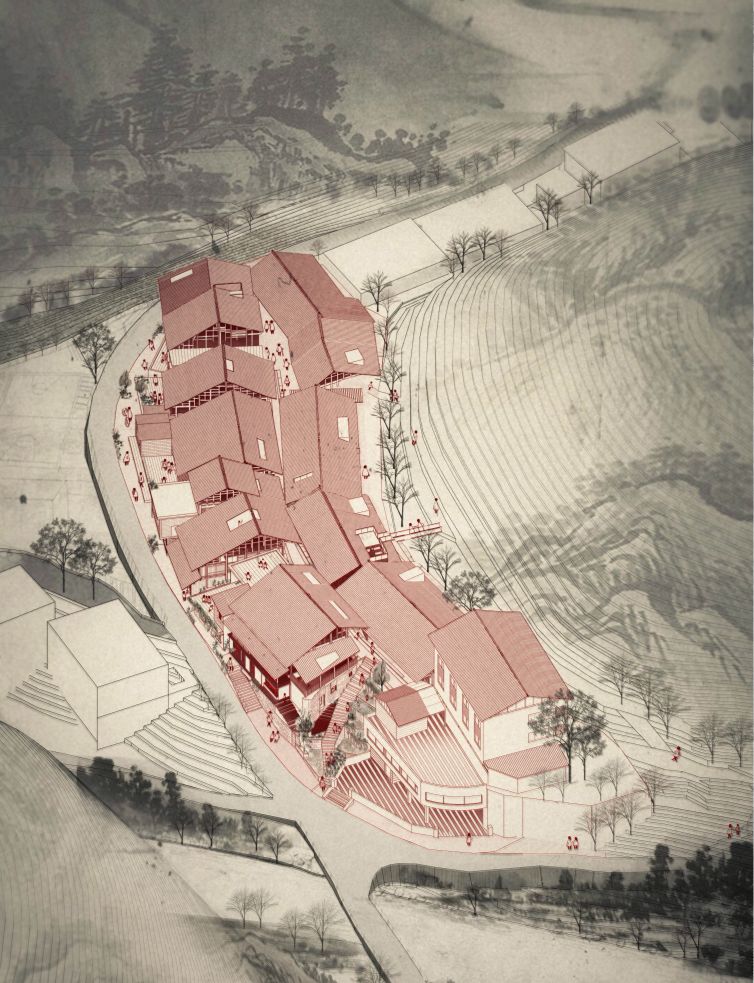
老街改造后场景畅想 The vision of the Old Street after reburfished
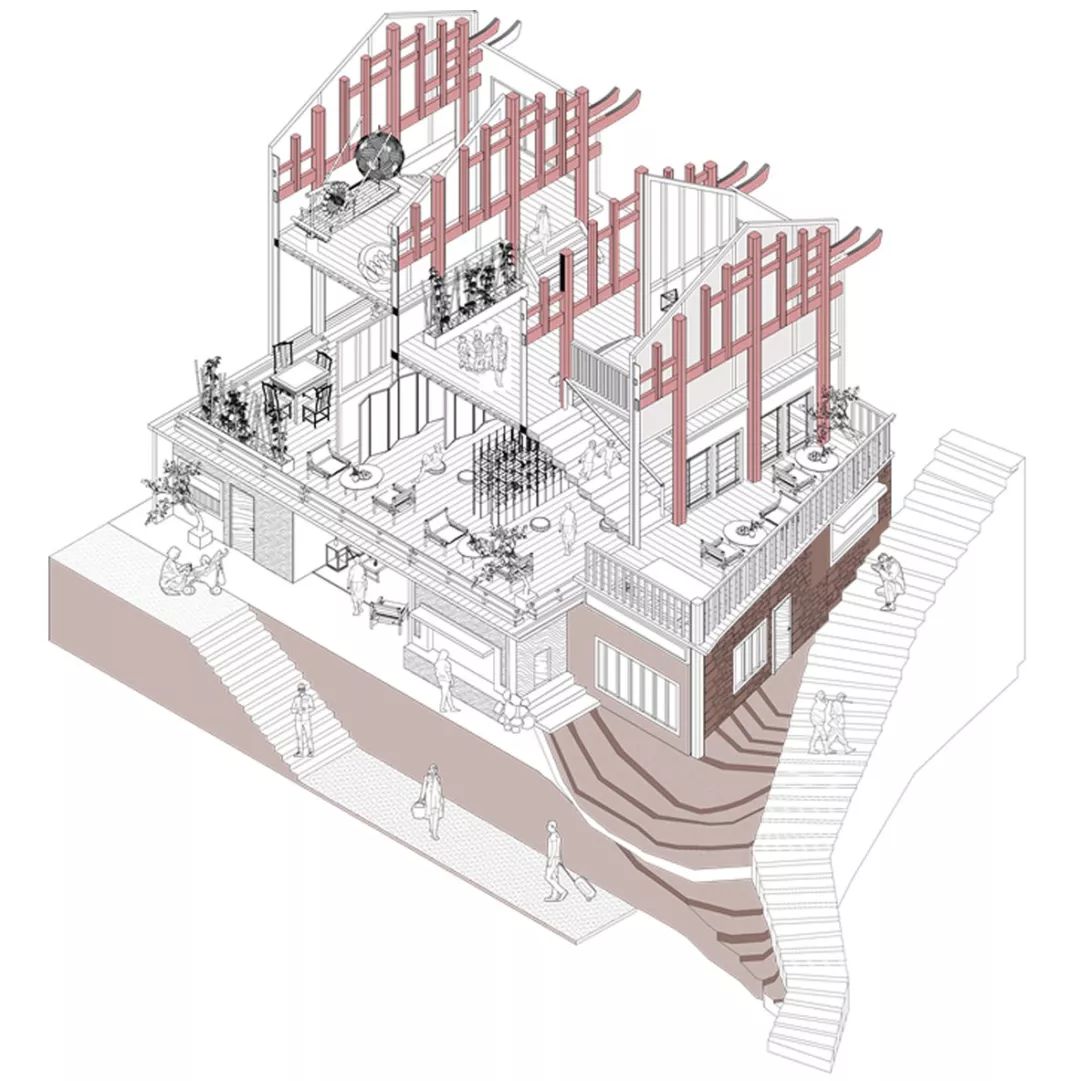
乡村生命体展览建筑轴测图 Axonometric drawing of the exhibition building
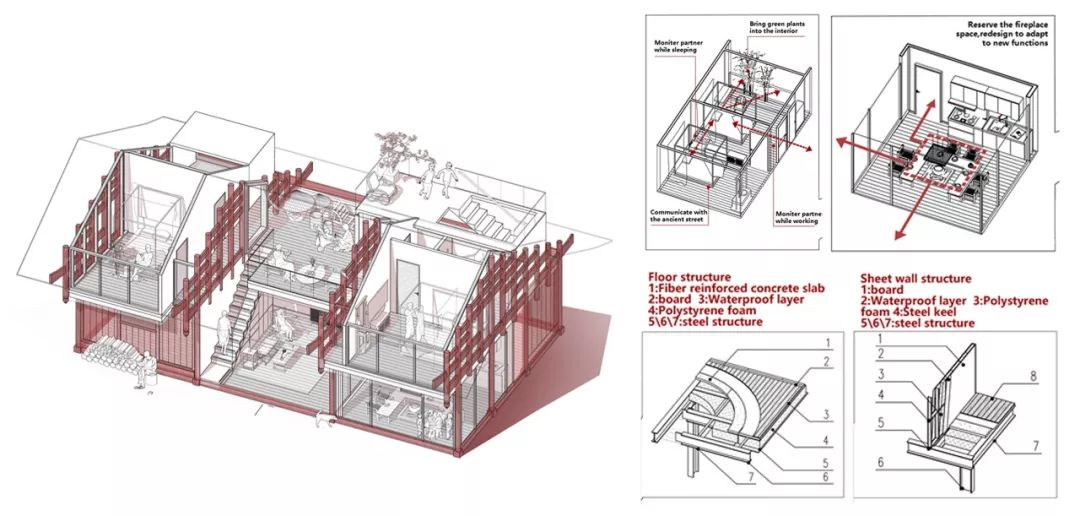
乡村生命体居住建筑空间与构造 Building space and structure of the design
5.阶段成果答辩
5.Presentation in Tufuri Hall, IUAV
2019年6月14日,“两河口:土家盐道古村的再生——国际四校联合研学营”阶段性成果汇报与评图在威尼斯建筑大学塔夫里报告厅举行,对过去近两个月的研究设计工作进行汇报、展示与交流。每个设计组进行20分钟的阶段成果工作展示,现场各校老师对方案设计进行点评。评图结束后,师生们进行了圆桌对话,共同探讨了此次研学营的心得体会,并对后续设计深化、成果的落地和展现做出了展望。
On June 14, 2019,"Lianghekou the Regeneration of an Ancient Tujia Village along Salt Road-- the presentation of works was held in Tufuri Hall in Università Iuav di Venezia (IUAV), to reportand communicate the research and design works in the past two months. Each designgroup conducted a 20-minute presentation of design project and teachers from fourschools commented on the final works. After the presentation, all teachers andstudents had a roundtable dialogue, discussed the experience of this joint studio,and made the prospect of the follow-up design deepening, implementation andexhibition works of the results.
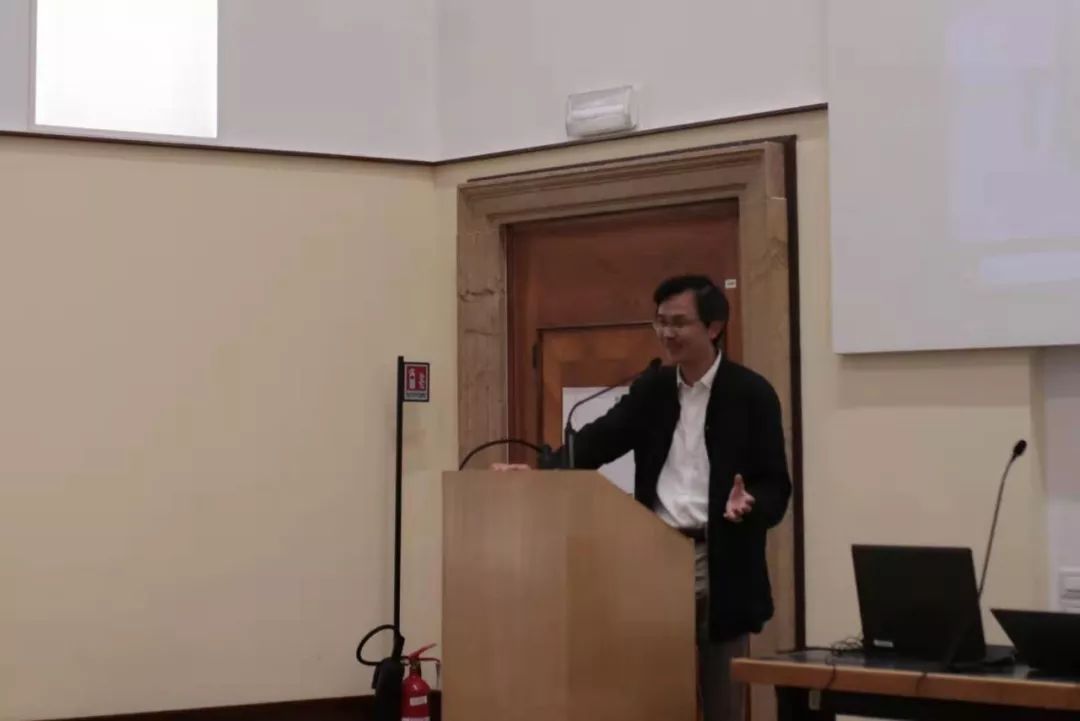
教师致辞 Speech of Tutors
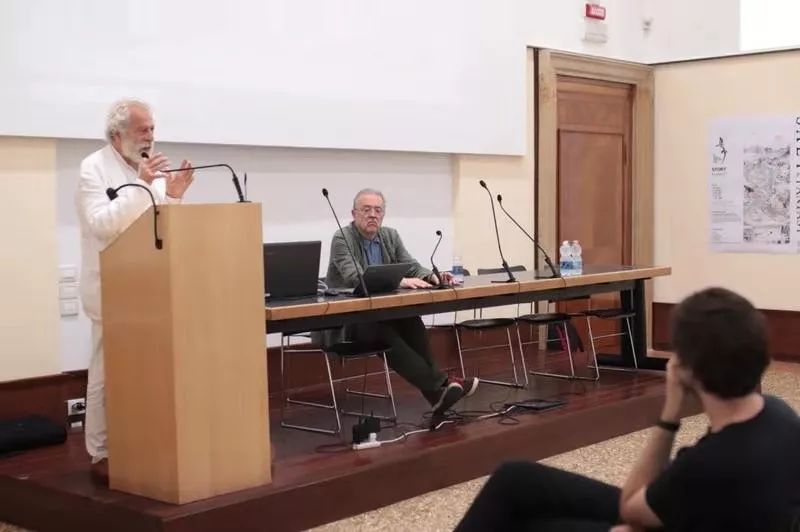
教师致辞 Speech of Tutors
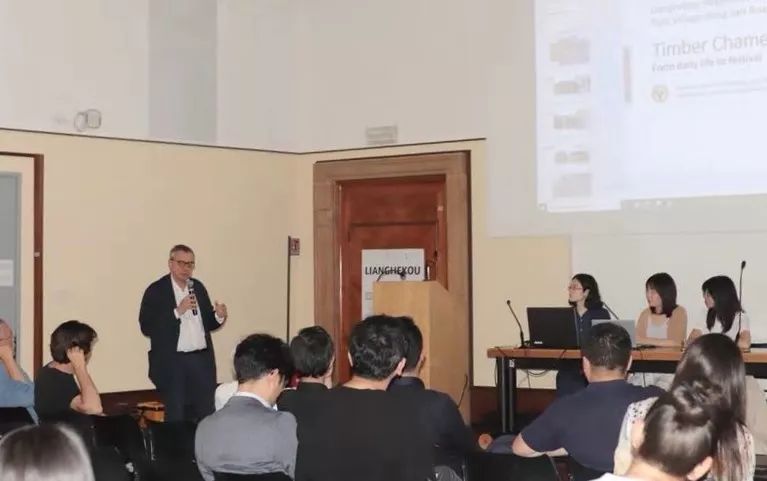
东南大学同学现场答辩 Design group of Southeast University
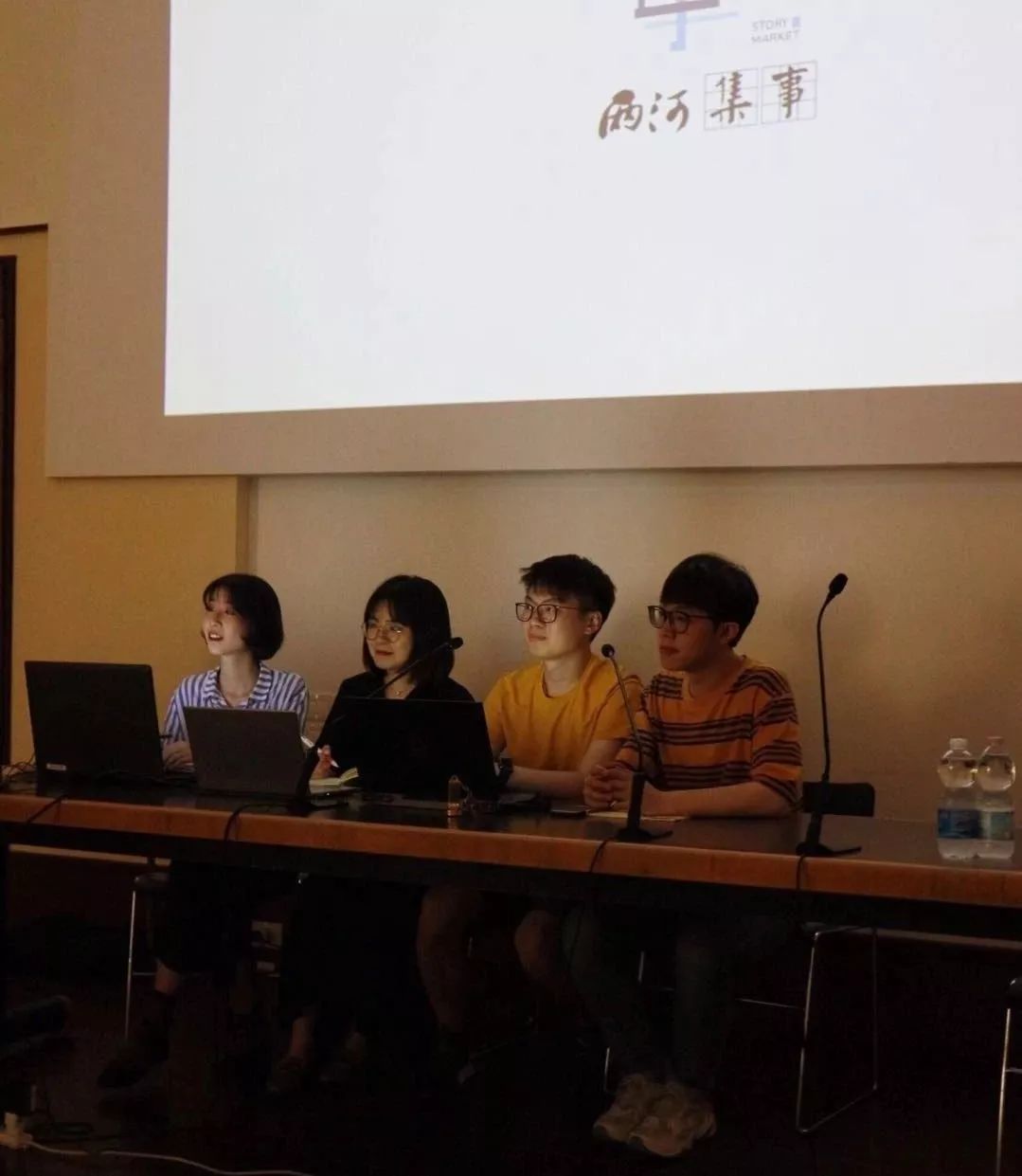
华中科技大学同学答辩 Design group of Huazhong University of Science and Technology
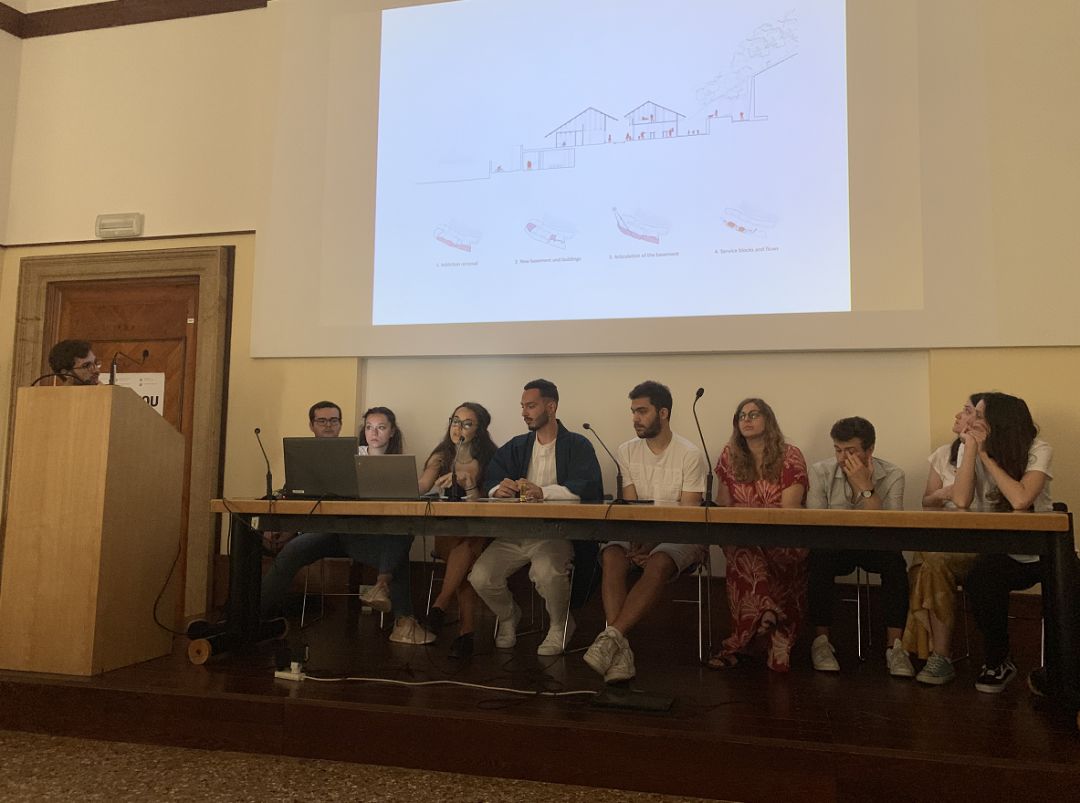
威尼斯建筑大学同学答辩 Design group of Università Iuav di Venezia
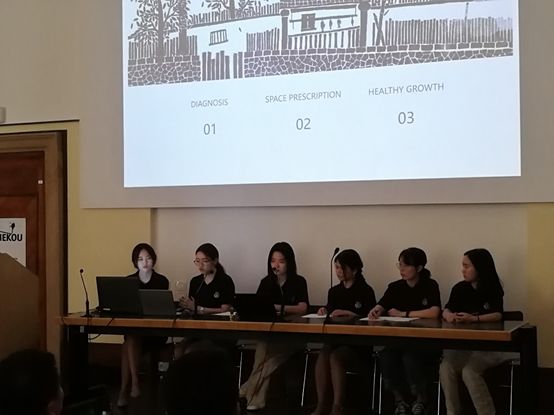
重庆大学同学现场答辩 Design group of Chongqing University

教师点评 Comments of Tutors
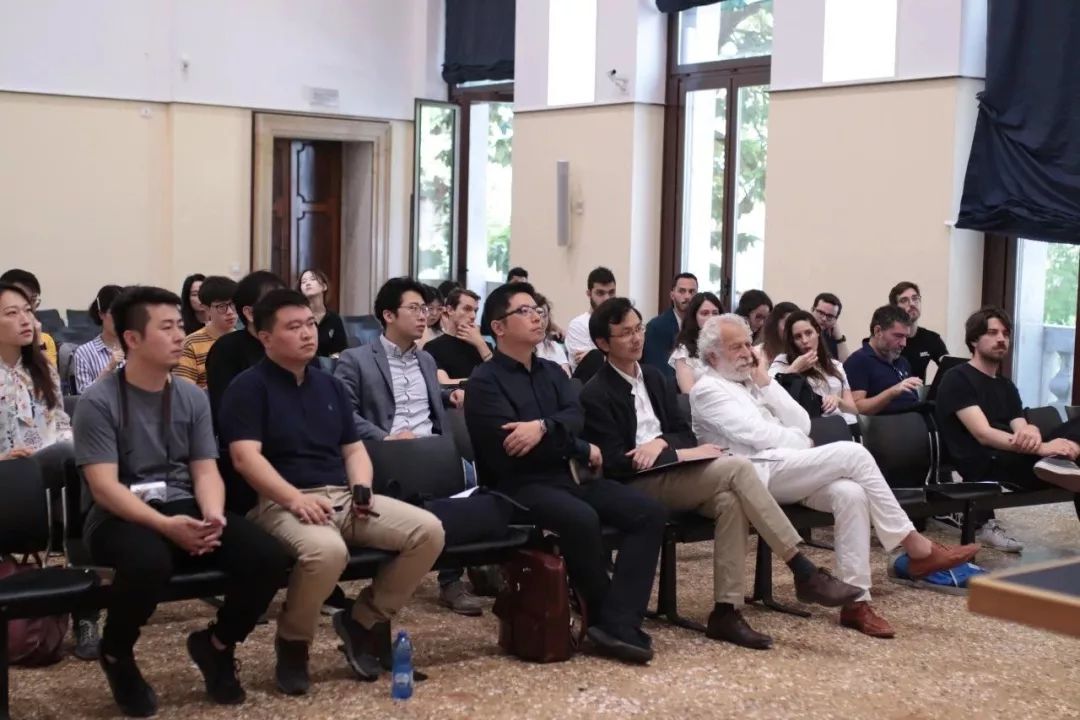
教师点评 Comments of Tutors
6.威尼斯“禅宫”展览
6.Exhibition in Palazzo Zen
答辩之后,工作营的阶段性成果在意大利雅伦格文化艺术基金会威尼斯禅宫展厅举办了展览,内容包含了两河口的前期调研测绘、主题研究成果以及各校提出的七个精彩设计方案。雅伦格⽂化艺术基⾦会主席⻢⾥诺·福林(Marino Folin)教授、威尼斯建筑大学副校长恩瑞克·方塔纳利(Enrico Fontanari)教授和建筑系主任奥尔多·阿莫尼诺(Aldo Aymonino)教授、院长张彤教授 以及四所高校的师生近百人齐聚雅伦格文化艺术基金会禅宫展厅,开启了为期十天的成果展览。
All of the design panels including mappings, topicsof researches as well as the seven projects designed by four universities wereexhibited in the EMG dort Art exhibition hall , Palazzo Zen on June 18th. Theexhibition lasted for ten days and attracted much attention from local studentsand media.
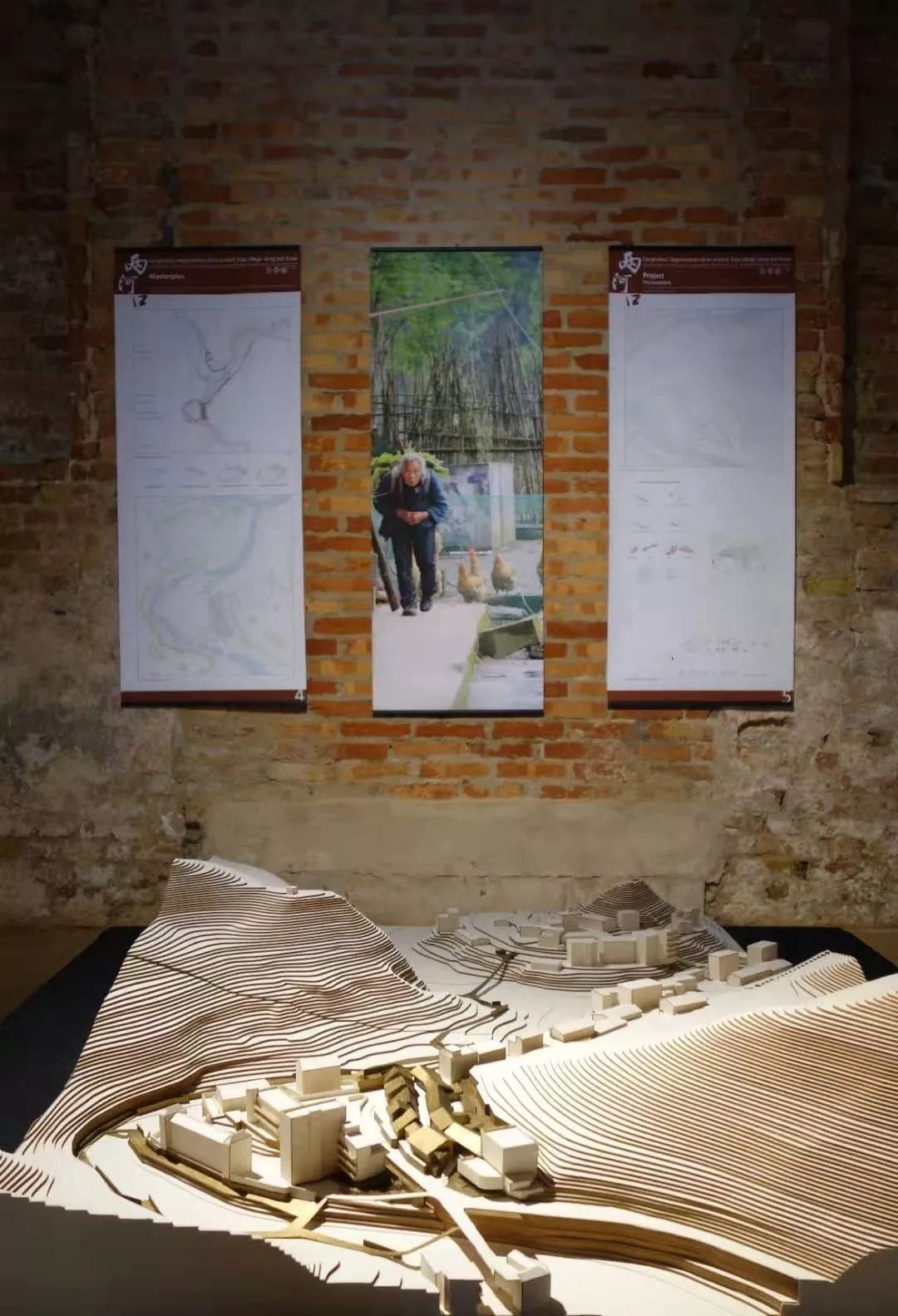 禅宫展览现场 The exhibition in Palazzo Zen
禅宫展览现场 The exhibition in Palazzo Zen
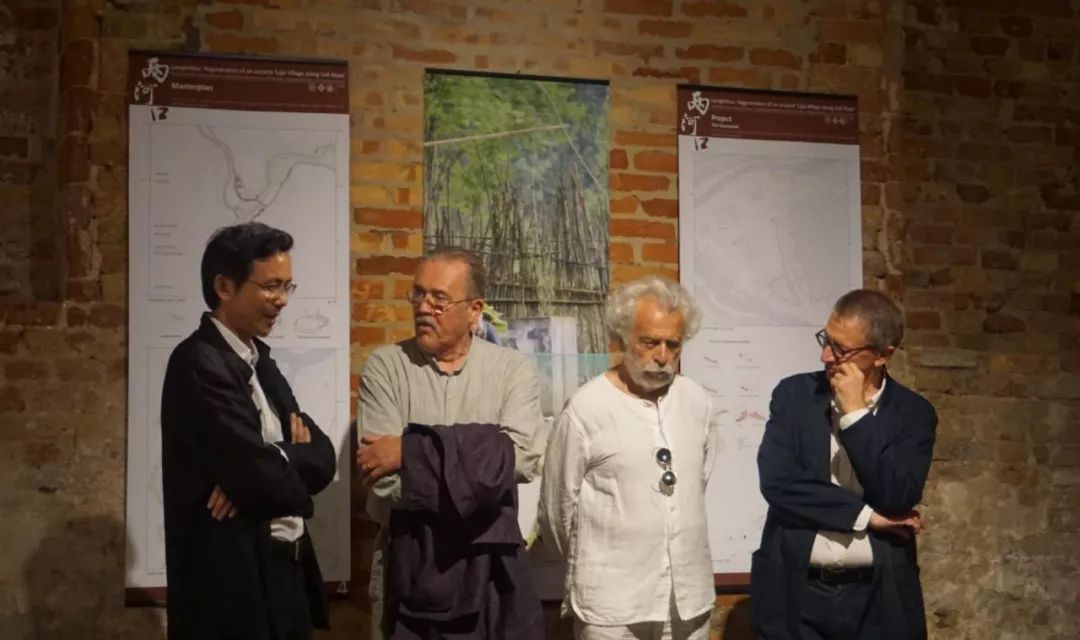
禅宫展览现场 The exhibition in Palazzo Zen
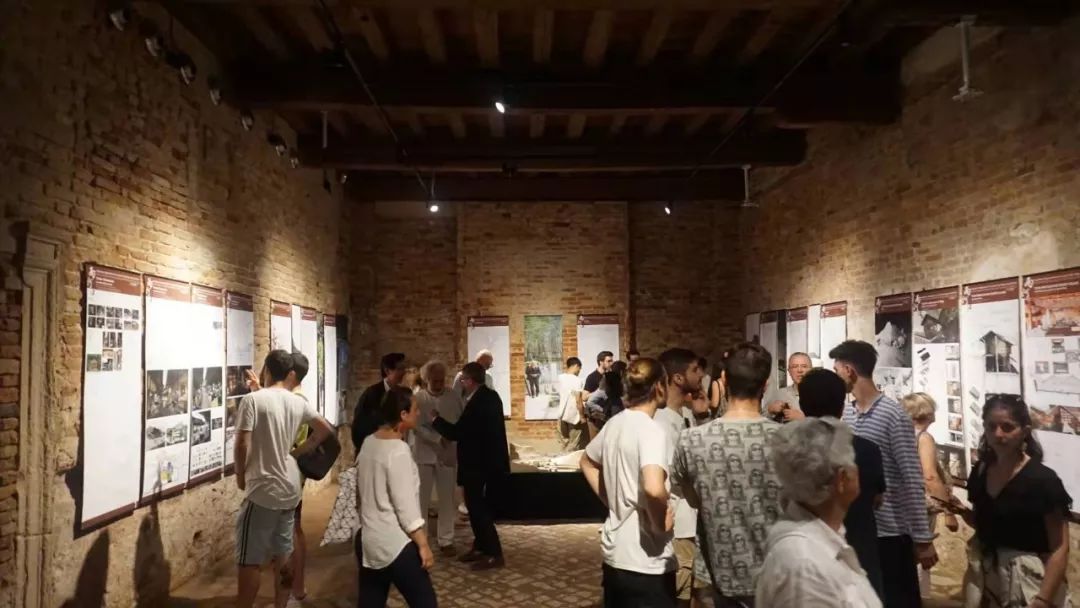
禅宫展览现场 The exhibition in Palazzo Zen
禅宫展览现场 The exhibition in Palazzo Zen

威尼斯当地媒体《Il Gazzettino 》日报6月18日刊对展览进行了现场报道
Venice local newspaper Il Gazzettino took a live report on the exhibition on June 18th
7.课程总结与思考
7.Studio summary
建筑学介入乡村需要关注原住民对自身文化价值的认同。设计如何发挥自身潜在的力量来改进和平衡文化遗产与现代旅游业以及城镇化发展之间的矛盾,是本次课程教学的出发点和值得持续思考的议题。教学过程中,来自不同文化背景的多所高校师生相互交流,思想碰撞,从场域生态、遗产保护、功能业态、活化改造、村镇公共空间营造等多个层面,对两河口村未来的发展提出了多种模式和策略的探索。在威尼斯禅宫的展览不是最终成果的展示,而是对这一富有价值探索的有力推进,希望通过展览与实践,使得教学中的思考能够产生更为深远而广泛的影响。
Architectural involvement in rural areas needs to focus on localpeople's recognition of their own cultural values. The starting point of thiscourse is how to exert architectural potential power to improve and balance thecontradiction between cultural heritage and modern tourism under theurbanization development. In the teaching process, teachers and students fromdifferent cultural backgrounds communicate with each other, and ideas exchanged.From the perspectives of field ecology, heritage protection, functionalformats, activation and reconstruction, and public space construction ofvillages and towns, various models and strategies are put forward for thefuture development of Langhekou village. The exhibition in Palazzo Zen is notthe display of the final result, but a powerful promotion of this valuableexploration, hoping that through the exhibition and practice to make thecontinuous thinking of education can have a more profound and extensive impact.
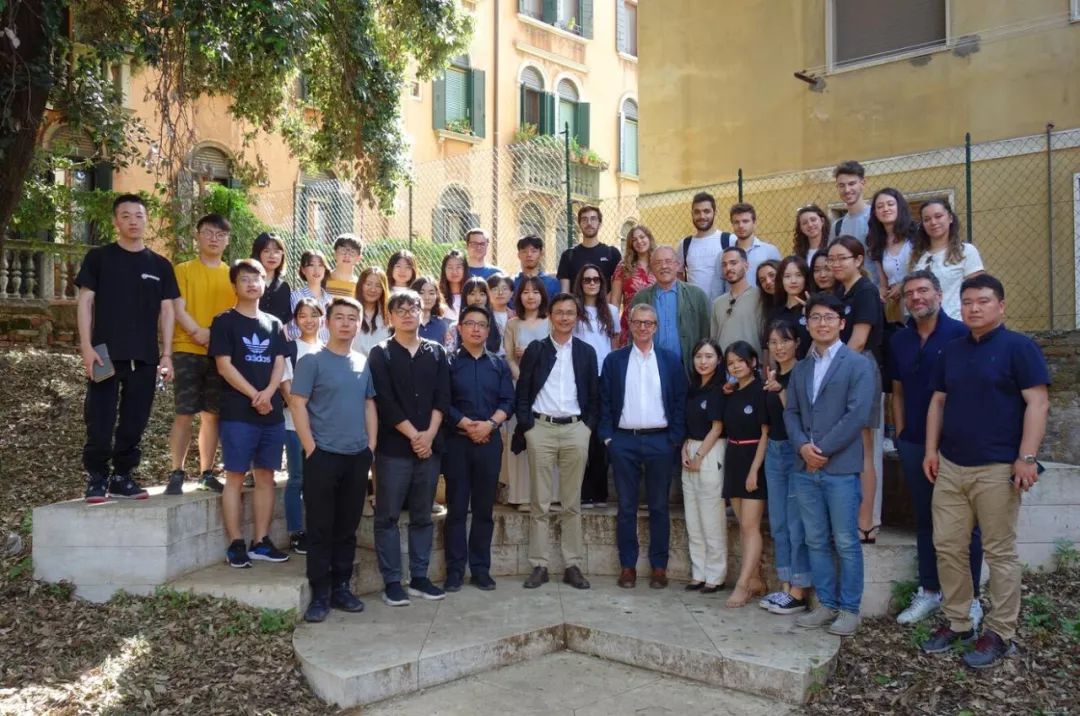
四校师生在威尼斯建筑大学合影留念
Teachers and students of four schools took a photography in IUAV
课程支持与资助:Supports and Funding
湖北省恩施土家族苗族自治州人民政府,宣恩县人民政府
The Municipal Government of Hubei EnshiTujia and Miao Autonomous Prefecture, The Municipal Government of Xuanen County
意大利雅伦格文化艺术基金会
Fondazione EMGdotART
东南大学教育基金会
The Education Foundation of Southeast University
指导教师:Tutors
东南大学:张彤,王川
华中科技大学:李保峰,汤诗旷,王通
威尼斯建筑大学:Aldo Aymonino, Enrico Fontanari, Giuseppe Caldarola
重庆大学:褚冬竹,宫聪
参与学生:Students
东南大学
徐涵,隋明明,陈斯予,马雨萌,陈韵玄,沈洁,闫宏燕,戈世钊,续爽,王瑢,李心然
华中科技大学
赵蕊,魏迪,张师维,王沛泽,彭欣怡,王宁,何仕轩,田淑颖,刘文玉(湖北美院),王长曦(湖北美院)
威尼斯建筑大学(IUAV)
G. Bordin, I. Bottino, D.Burro, D. Bruneri, A. Canton, E. Cielo, M. D'Altoè, A. Marsella, T. Ortolan, G.Rettore, I. Rosolen, A. Sparapan, A. Zen
重庆大学
顾明睿,阳蕊,李晨,吴霜,黄金静,戴连婕
特邀答辩评委:Specially Distinguished Juror
The President of Fondazione EMGdotART,Professor Marino Folin
雅伦格⽂化艺术基⾦会秘书长姚京
副教授邓浩


